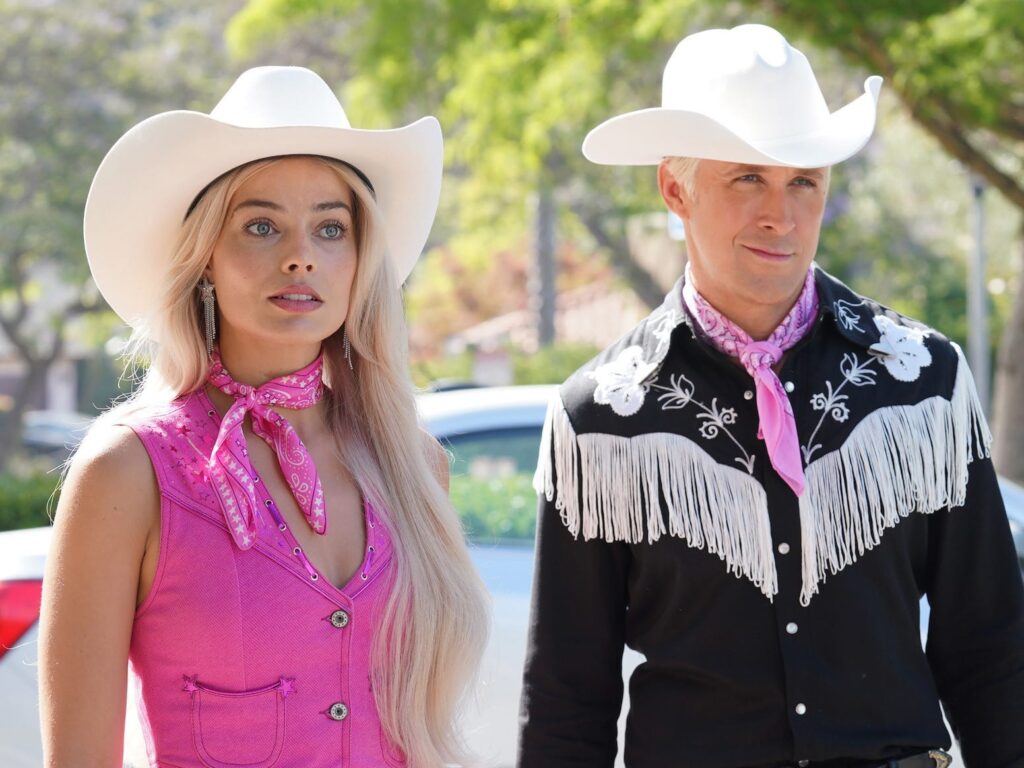- Waarschuwing: dit artikel bevat spoilers voor de Barbie-film van Greta Gerwig met Margot Robbie in de hoofdrol.
- De film bevat bevat talloze referenties aan de Babrbie-poppen die producent Mattel in de loop der jaren uitbracht.
- Insider zet 42 verwijzingen op een rijtje die je misschien hebt gemist.
- Lees ook: De belangrijkste scène uit ‘Barbie’ was bijna uit de film gehaald.
Volgens The Hollywood Reporter bracht “Barbie” in het openingsweekend 155 miljoen dollar op in de VS, en wereldwijd zelfs 337 miljoen dollar.
Het is de meest lucratieve openingsweekend van een vrouwelijke regisseur ooit geworden, een record dat eerder in handen was van Patty Jenkins’ Wonder Woman, die ruim 100 miljoen dollar opbracht in het openingsweekend.
De film bevat veel verwijzingen naar de Barbie-poppen die producent Mattel in de loop der jaren heeft uitgebracht. Insider zet 42 verwijzingen en details op een rij die je misschien hebt gemist.
Bekijk het volledige overzicht in de slideshow hieronder.
42 details uit de film Barbie die je misschien zijn ontgaan
42 details uit de film Barbie die je misschien zijn ontgaan
-
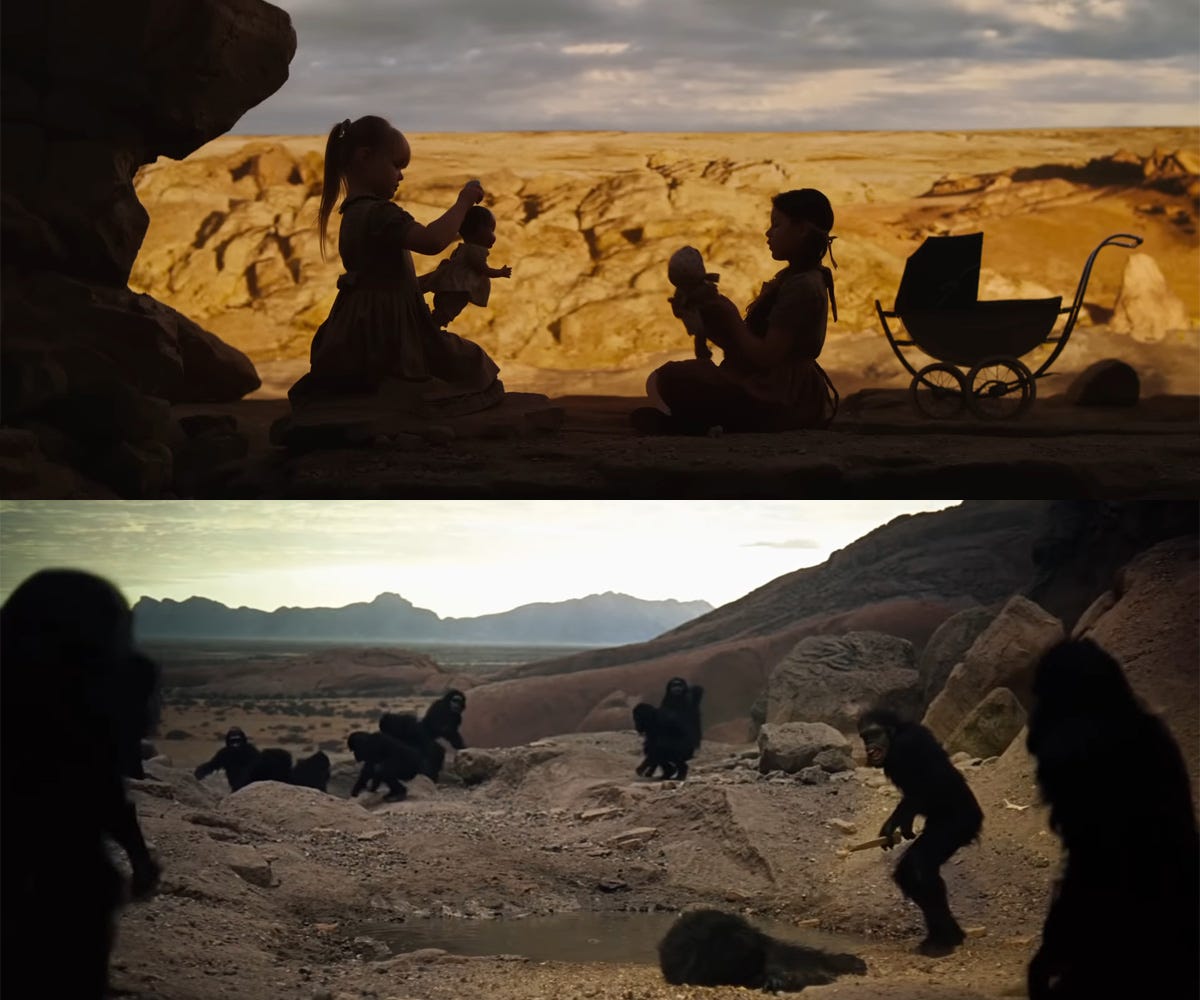
The opening scene is an homage to Stanley Kubrick's "2001: A Space Odyssey."
The opening scene of "Barbie" is mostly what was shown in the first teaser trailer for the movie, depicting the dawn of Barbie. A group of girls are seen playing with boring dolls until they meet Stereotypical Barbie (Margot Robbie) standing above them in all her glory.
This is a reference to the opening of "2001: A Space Odyssey," which depicts the dawn of mankind as monkeys encounter a monolith.
This implies that the creation and development of Barbie contributed to the evolution of young girls, which explains the meaningful connection between Robbie's Barbie and the grown-up Gloria (played by America Ferrera).
Warner Bros.; MGM
-
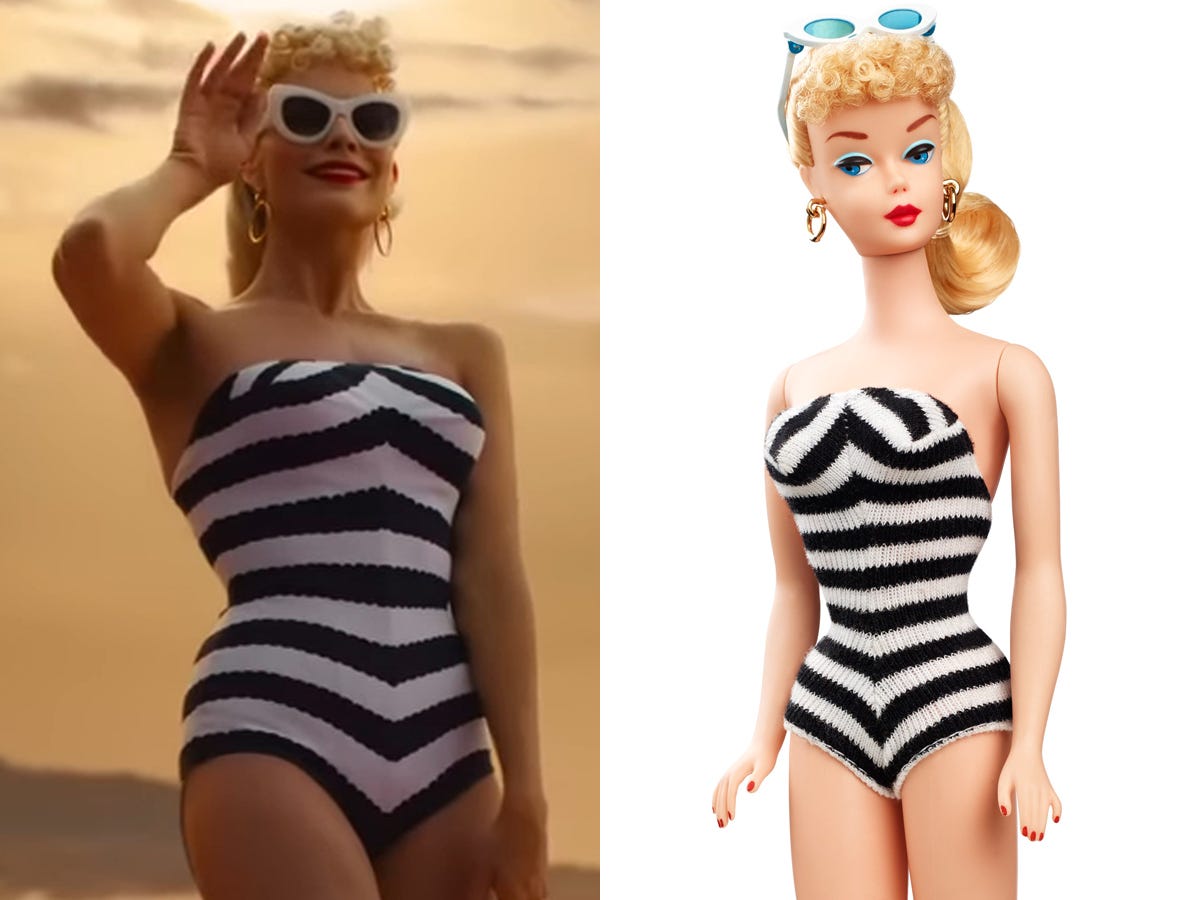
In the same scene, Robbie's Barbie wears the exact swimsuit of the first-ever Barbie doll that Mattel released in 1959.
In an homage to the original Barbie doll, Robbie wears the same black-and-white one-piece swimsuit, black heels, retro white-framed sunglasses, and gold hoop earrings.
Her blonde hair is also styled in a similarly curly fashion.
Warner Bros.; Mattel
-
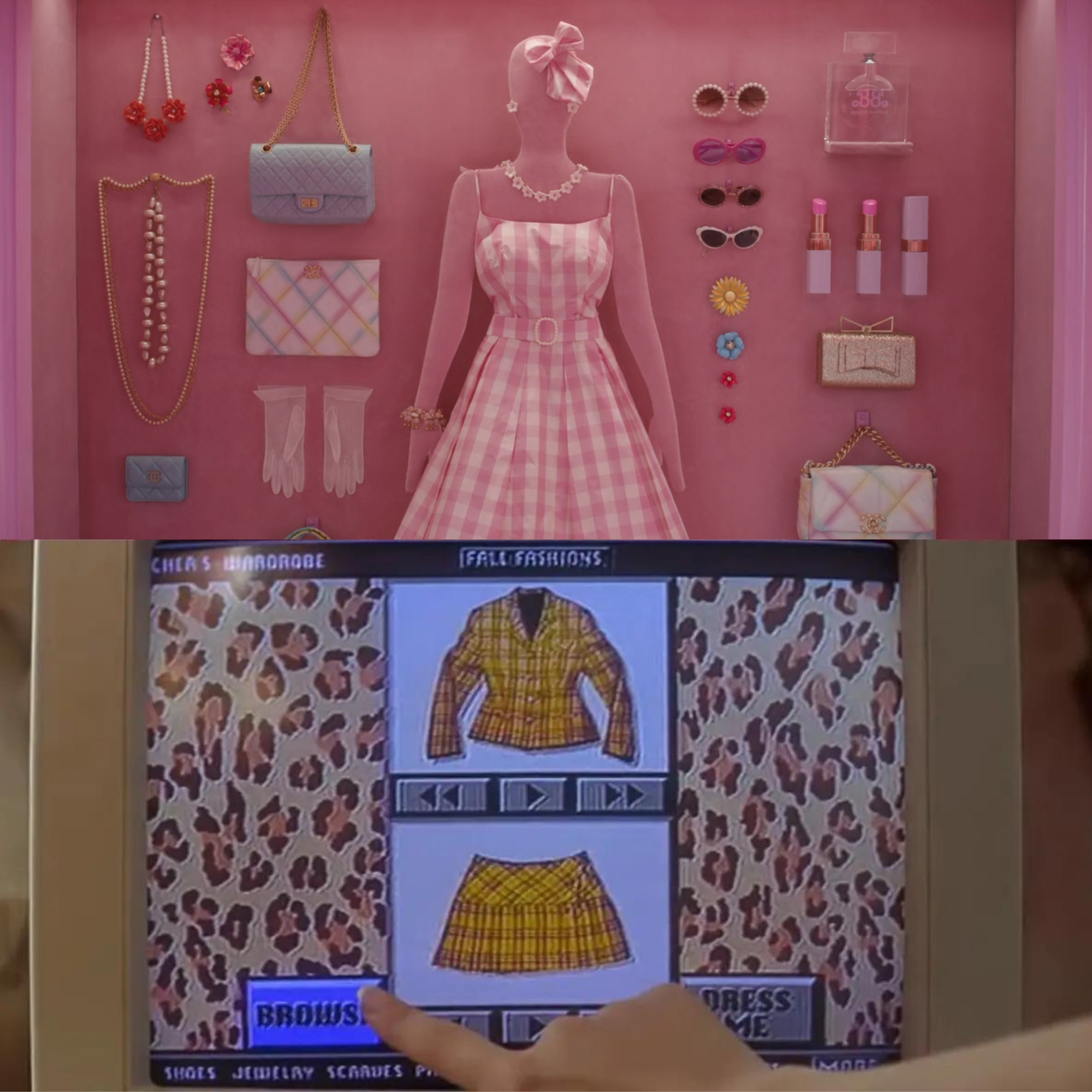
Barbie's closet takes inspiration from the hit movie "Clueless."
In "Clueless," Cher Horowitz picks out her iconic outfits by skimming through her virtual wardrobe on her computer. In "Barbie," the titular character magically gets dressed each morning by standing in front of her closet.
"This was a design thing that we were really excited about," Robbie told Architectural Digest during an on-set tour of the Barbie Land set. "We were saying that the wardrobe in 'Clueless,' the bar was set so high and we would really like to do something that is as cool as that."
Warner Bros.; Paramount Pictures
-
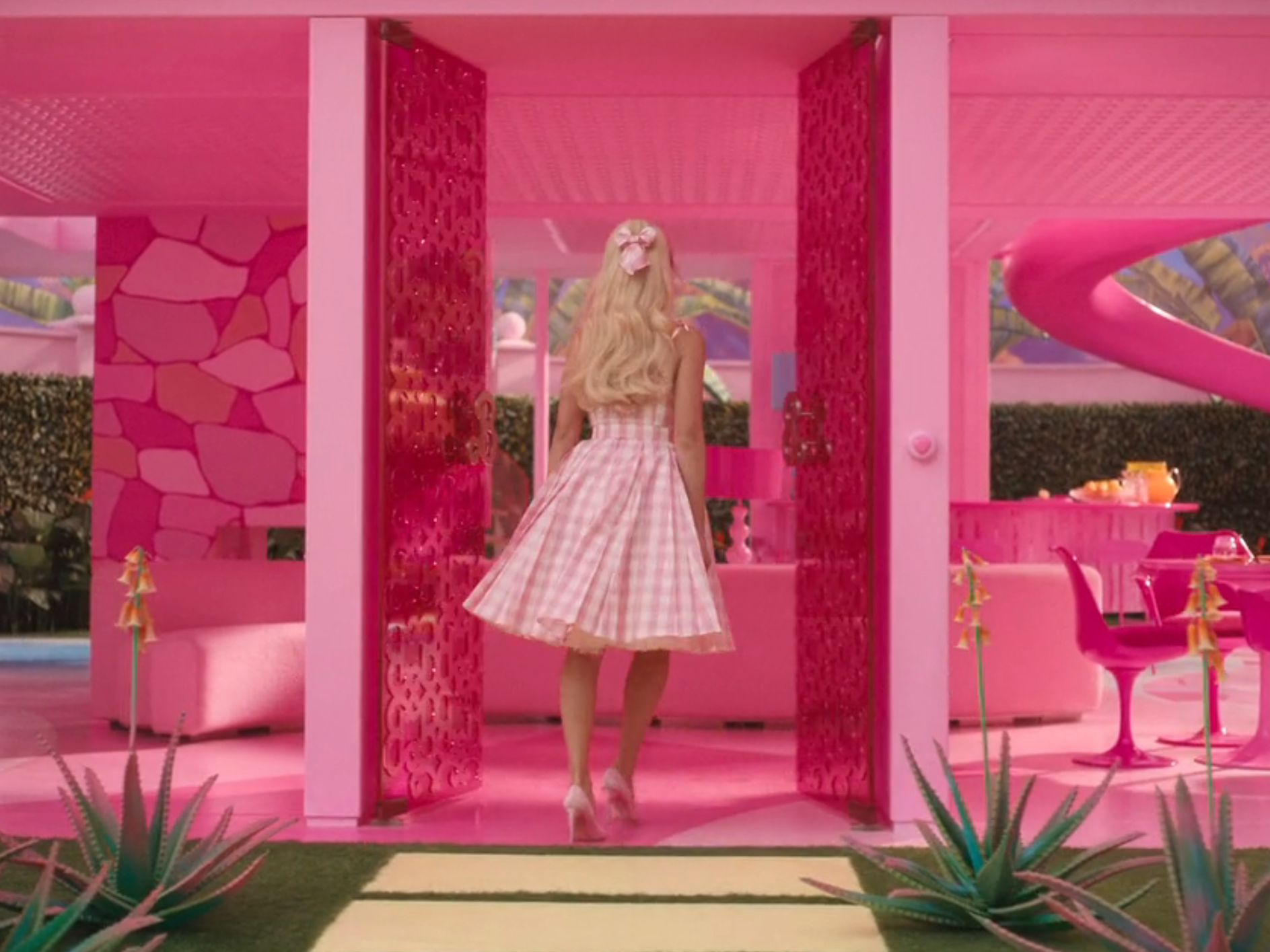
There are no windows or outer walls in Barbie Land.
While there are inner walls, each house is open for everyone to look in. This reflects a dollhouse, since Barbie Land is toy-like in its appearance, and also represents how innocent the imaginative realm is.
There are no secrets or hidden agendas in Barbie Land, so when Stereotypical Barbie starts to wonder about death, she's unable to hide it from her neighbors.
The openness within Barbie Land also fits with the recurring biblical themes in the movie, presenting the realm like the Garden of Eden before humans learned about shame and sin.
Warner Bros.
-
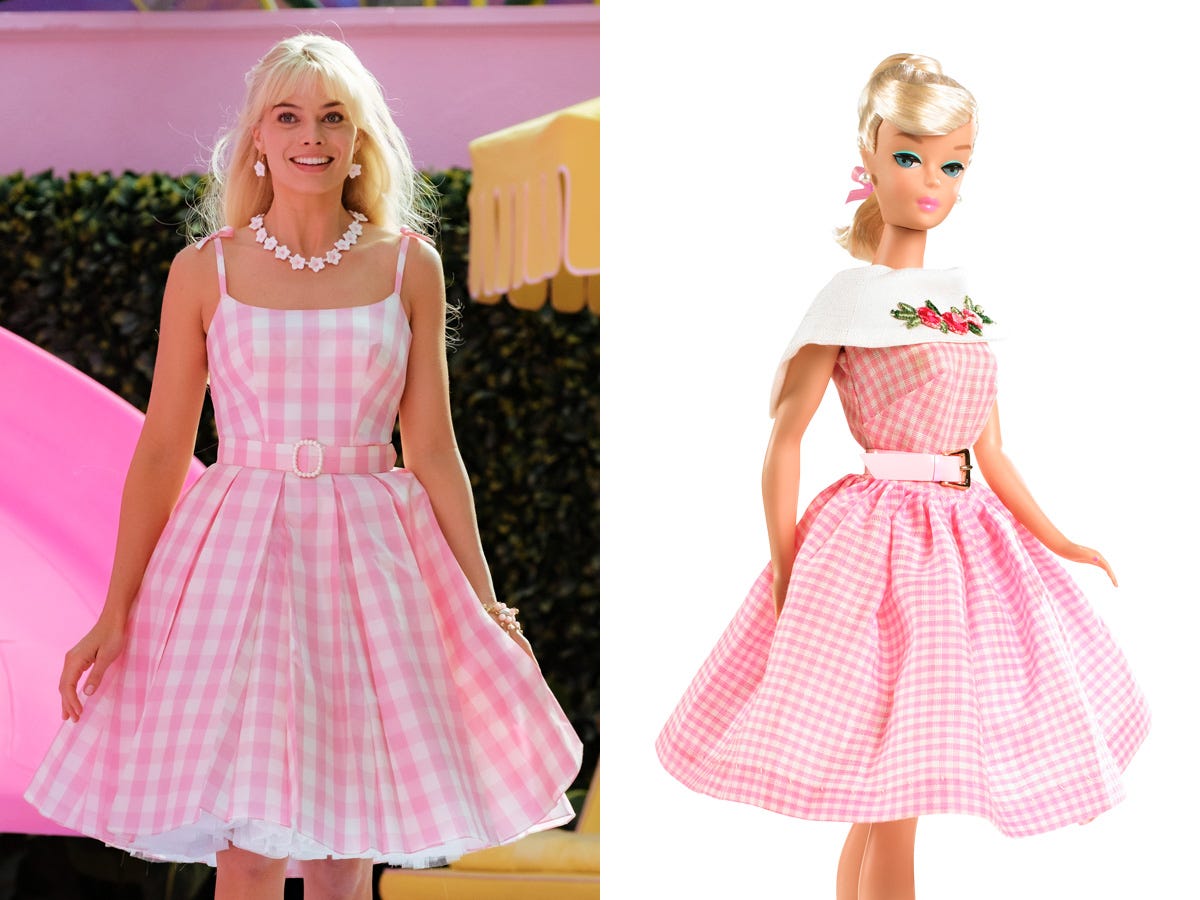
Her pink gingham dress looks like it was inspired by the 1964 Dancing Doll Barbie.
Several of Robbie's outfits in "Barbie" appear to have drawn inspiration from past iterations of the Mattel dolls.
Jaap Buitendijk/Warner Bros.; Mattel
-
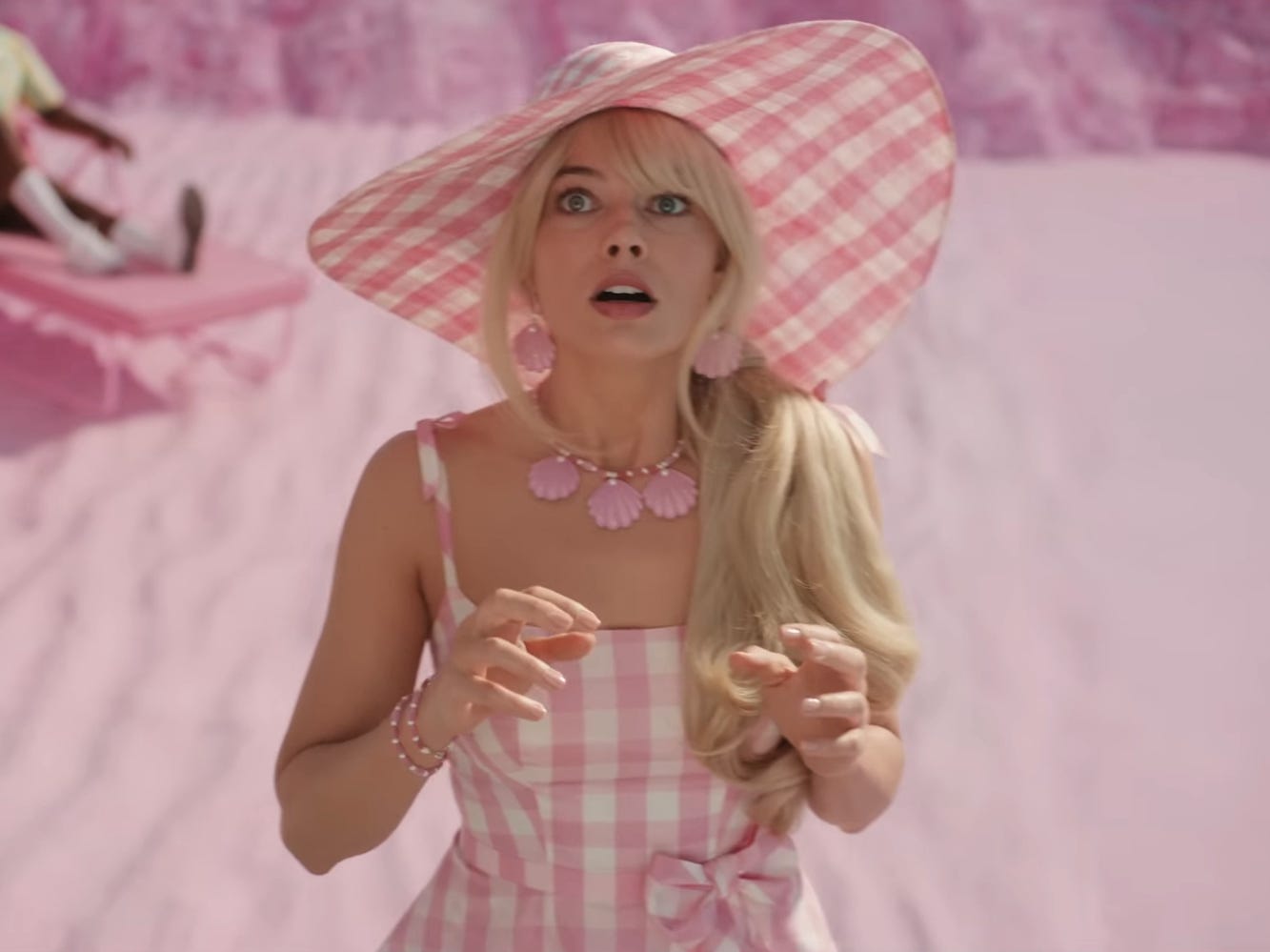
Robbie's character never wears any rings.
This is similar to the design of Mattel's dolls, whose fingers are all connected and can't detach for accessories.
Warner Bros.
-
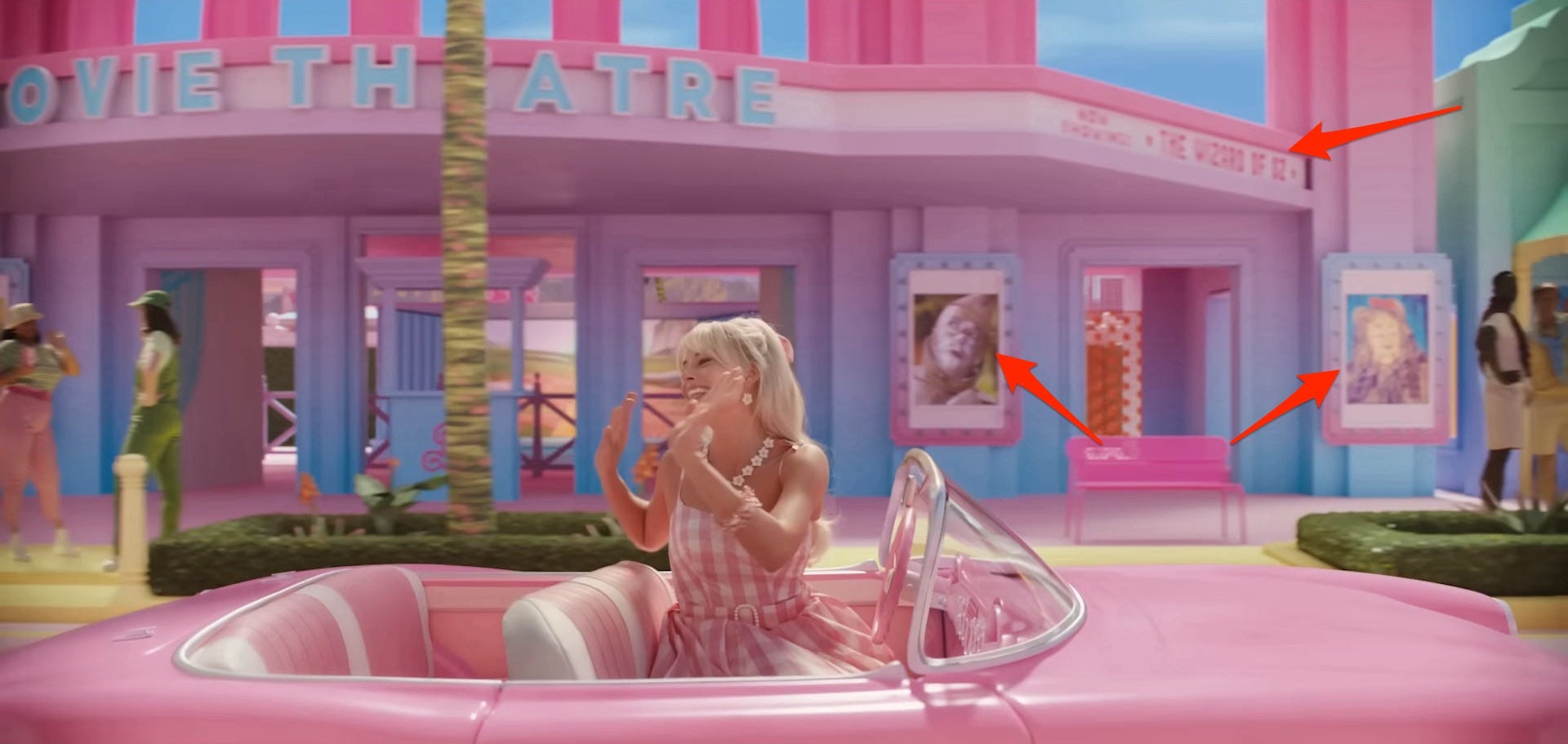
As Stereotypical Barbie drives through Barbie Land, she passes a movie theater marquee that's playing "The Wizard of Oz."
There are also posters of the film's main characters outside of the theater.
In "The Wizard of Oz," a naive girl named Dorothy goes on a similar journey to another world, encountering new friends along the way.
Warner Bros.
-
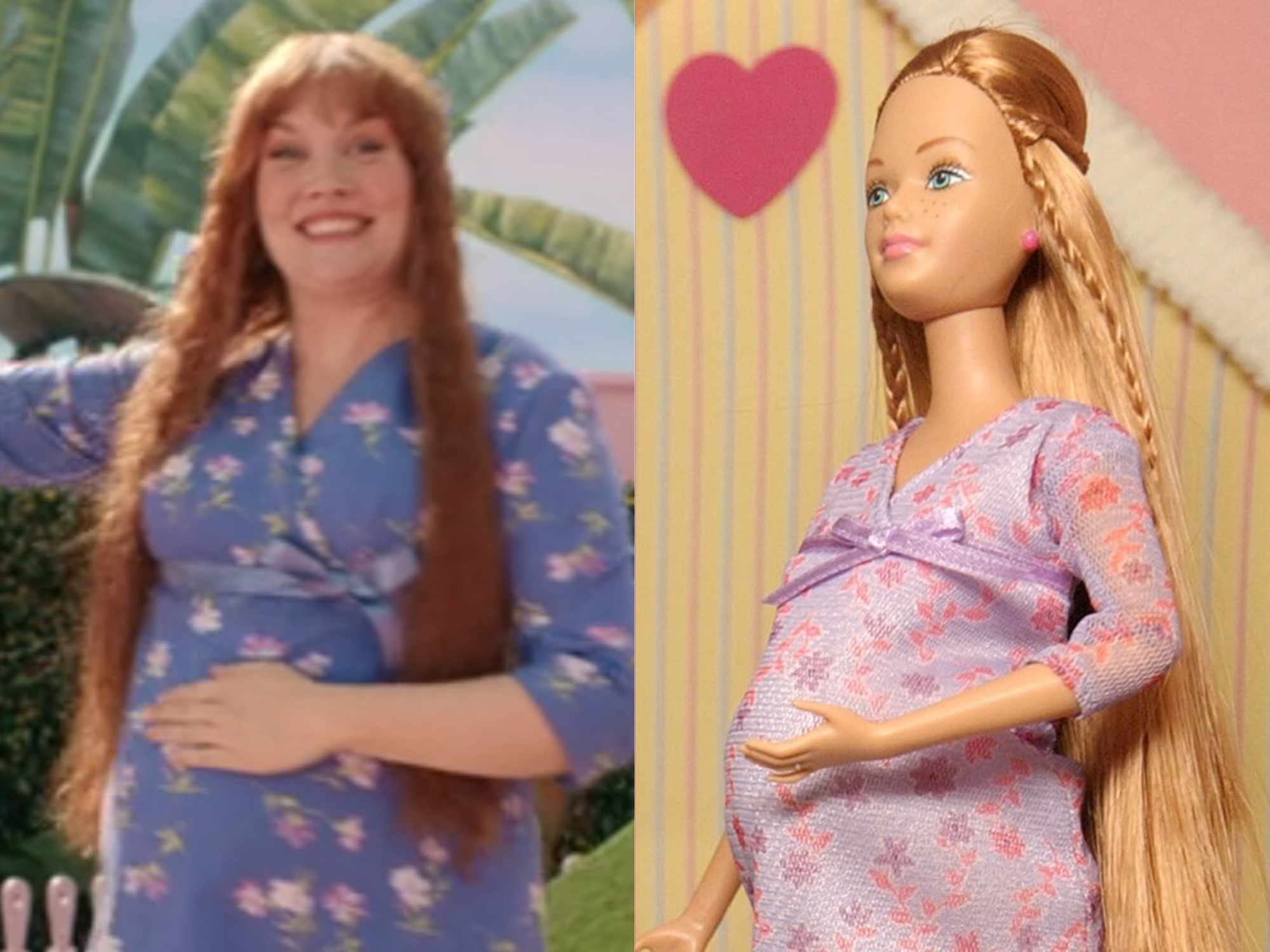
There are multiple references to Midge, a pregnant Barbie doll who was discontinued in real life.
In Gerwig's film, Midge is played by actor, writer, and director Emerald Fennell.
Warner Bros.; Lawrence Lucier/Getty Images
-
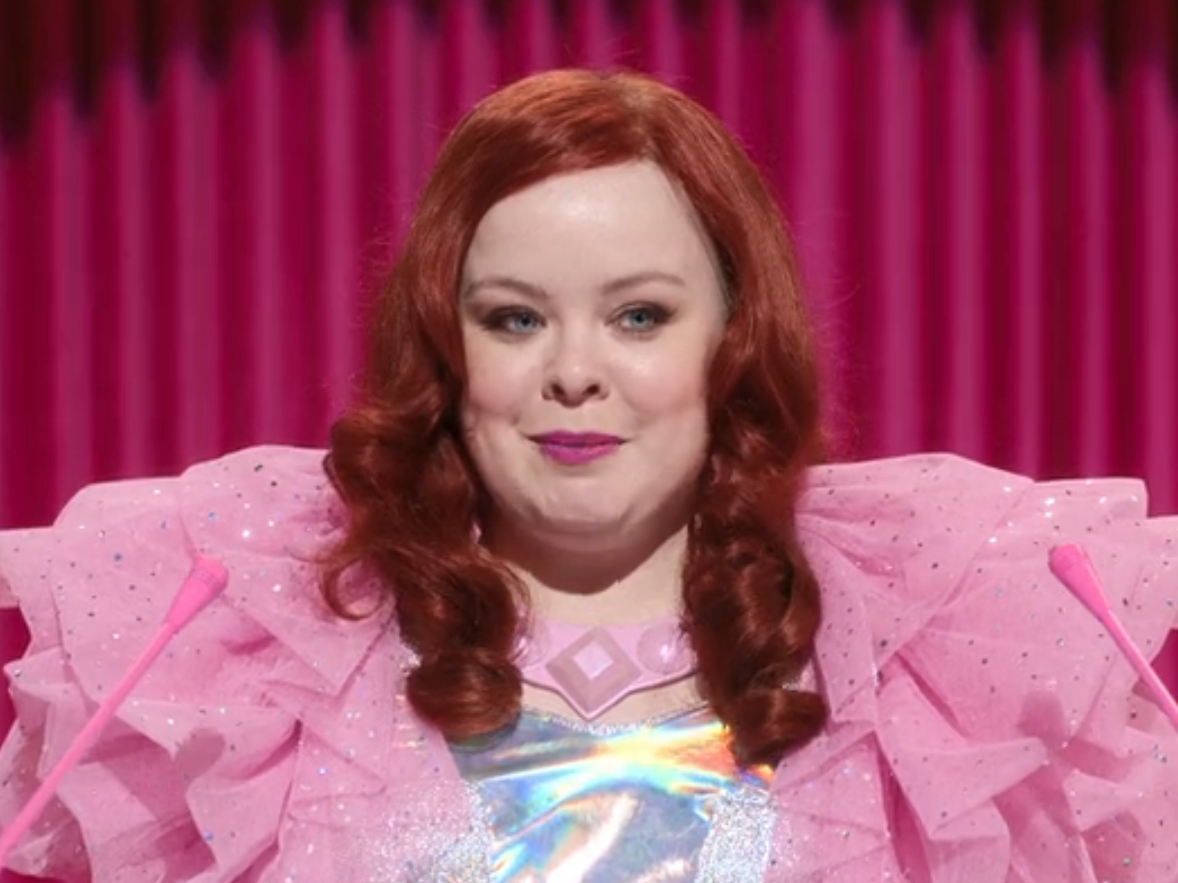
"Bridgerton" star Nicola Coughlan has a cameo as Diplomat Barbie.
Her main role is early in the movie, when she gives out awards, including a Nobel Peace Prize, to different Barbies.
When the Kens take over Barbie Land, she is replaced by Ken Emcee, who's played by "Love Island UK" star Chris Taylor.
Taylor told Cosmopolitan that he got the role after meeting Robbie at an afterparty for "Birds of Prey."
Robbie is famously a big fan of the UK reality-dating show and Taylor said that a year and a half after the afterparty, he got an email from Warner Bros. asking him to audition for "Barbie."
"I was fully convinced it was a prank," Taylor said. "These YouTubers, they're clever, they'll write full on contracts and do the prank video. But I pulled up at Warner Brothers and saw Ryan Gosling walked past my car and I thought 'this definitely isn't a prank.'"
Warner Bros.
-
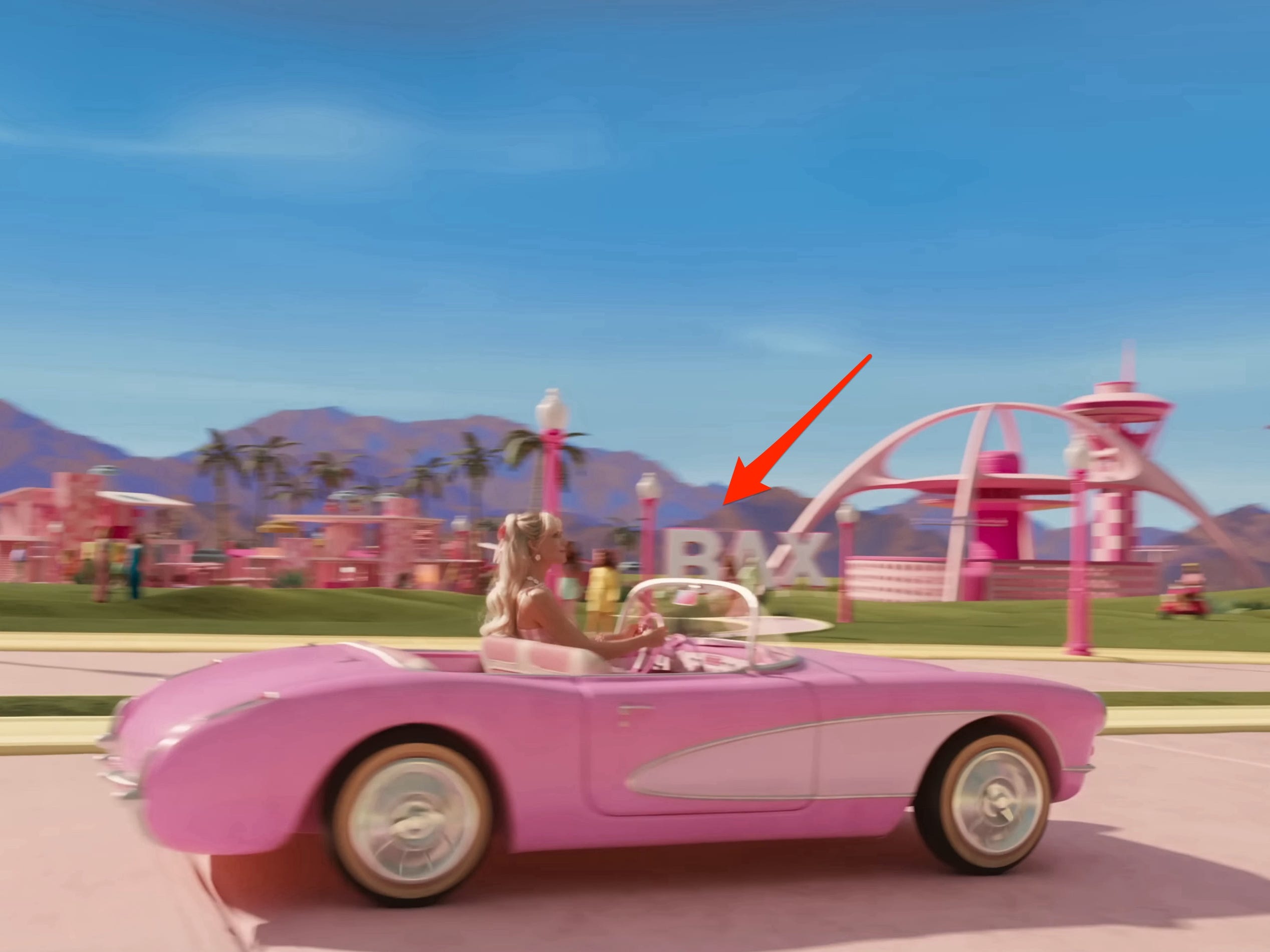
Barbie Land has an airport called BAX.
It's unclear where the planes are flying to in Barbie Land.
Warner Bros.
-
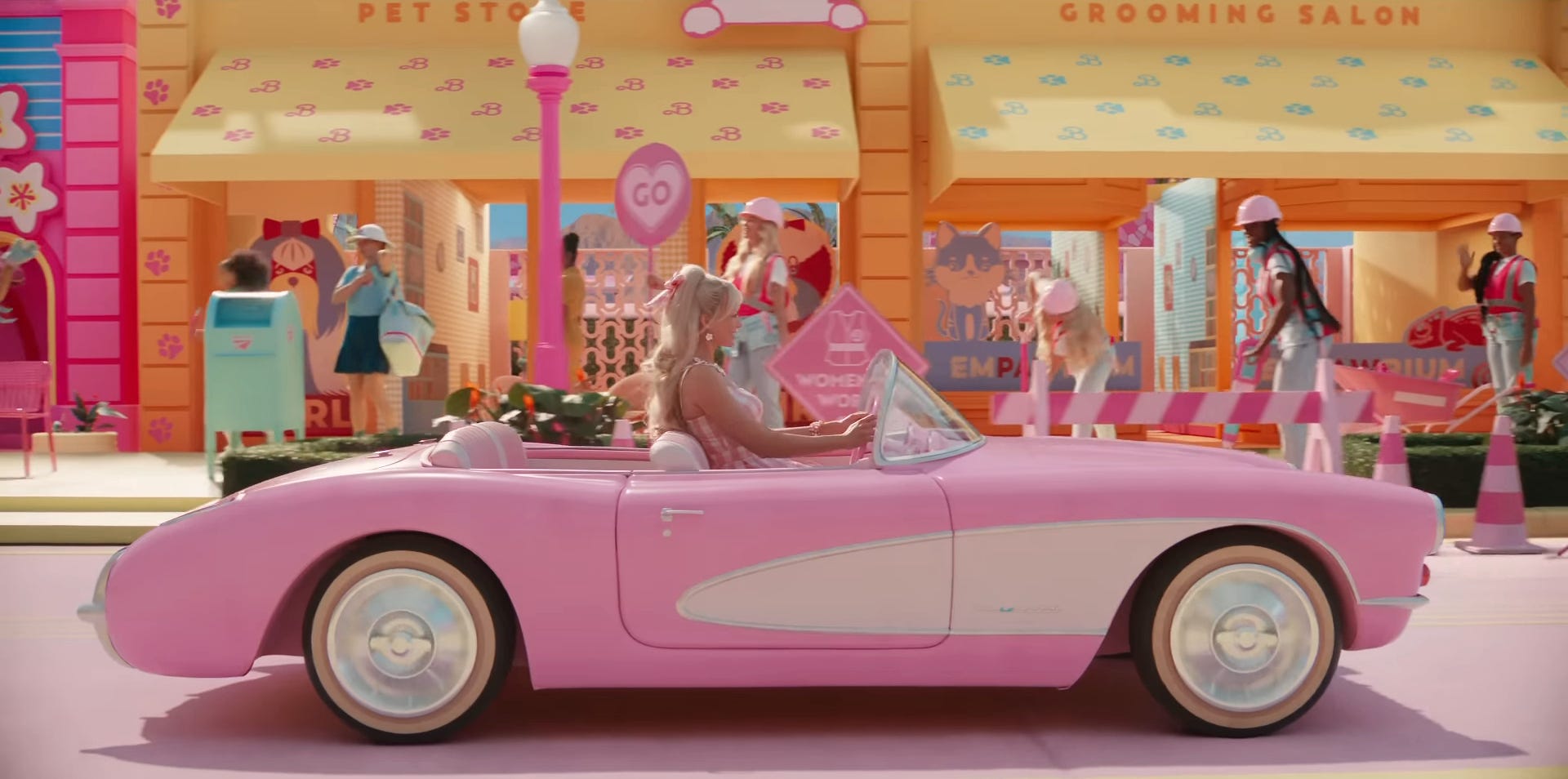
Stereotypical Barbie's pink convertible is purposely a little too small for her.
According to Time magazine, Gerwig "insisted" on the car being slightly disproportionate, similar to the actual toys.
Warner Bros.
-
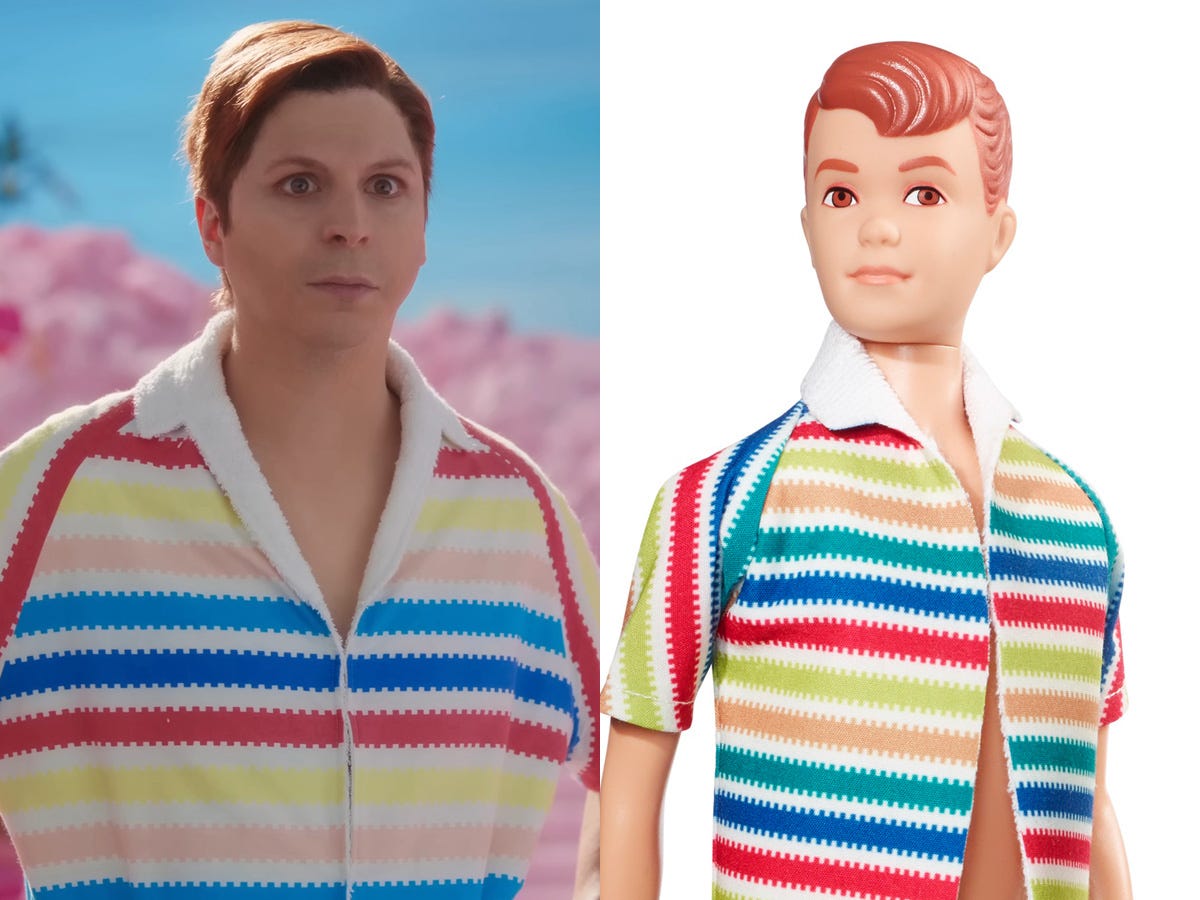
Michael Cera's Allan wears the same outfit as the original doll of the same name.
The doll was created in 1964 to provide a best friend for Ken and a boyfriend for Midge, Barbie's best friend.
According to Attitude, Allan's closeness to Ken and the fact they could wear each other's clothing led to rumors that the dolls were secretly in a homosexual relationship.
In the movie, Allan continues that role of being Ken's best friend — though he mostly just watches from the sidelines.
Warner Bros.; Mattel
-
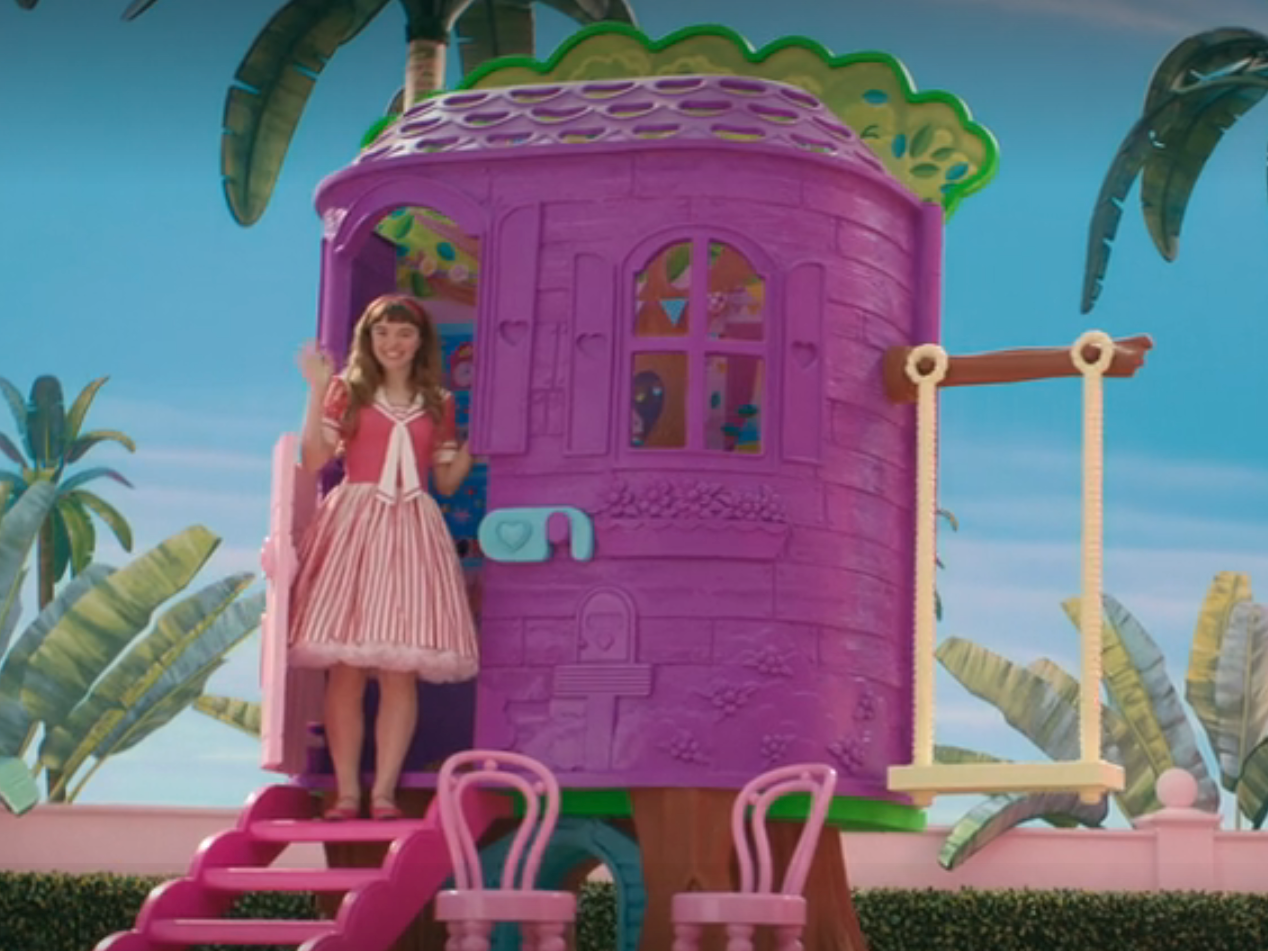
Skipper, Barbie's younger sister, is referenced numerous times in the movie.
One of the core dolls in the Barbie brand family is Skipper, Barbie's sister.
Skipper is referenced early in the film, living in a treehouse next to the other Barbie Dreamhouses. This treehouse is a replica of the real-life Mattel toy.
She's later referenced by the Mattel businessmen, as another rogue doll who had previously come to the real world from Barbie Land and caused a mess for the brand.
There's also a Growing Up Skipper doll that appears in the final act of the movie as part of a group of discontinued dolls. In real life, this version of Skipper could grow breasts when you pushed the doll's arm.
Warner Bros.
-
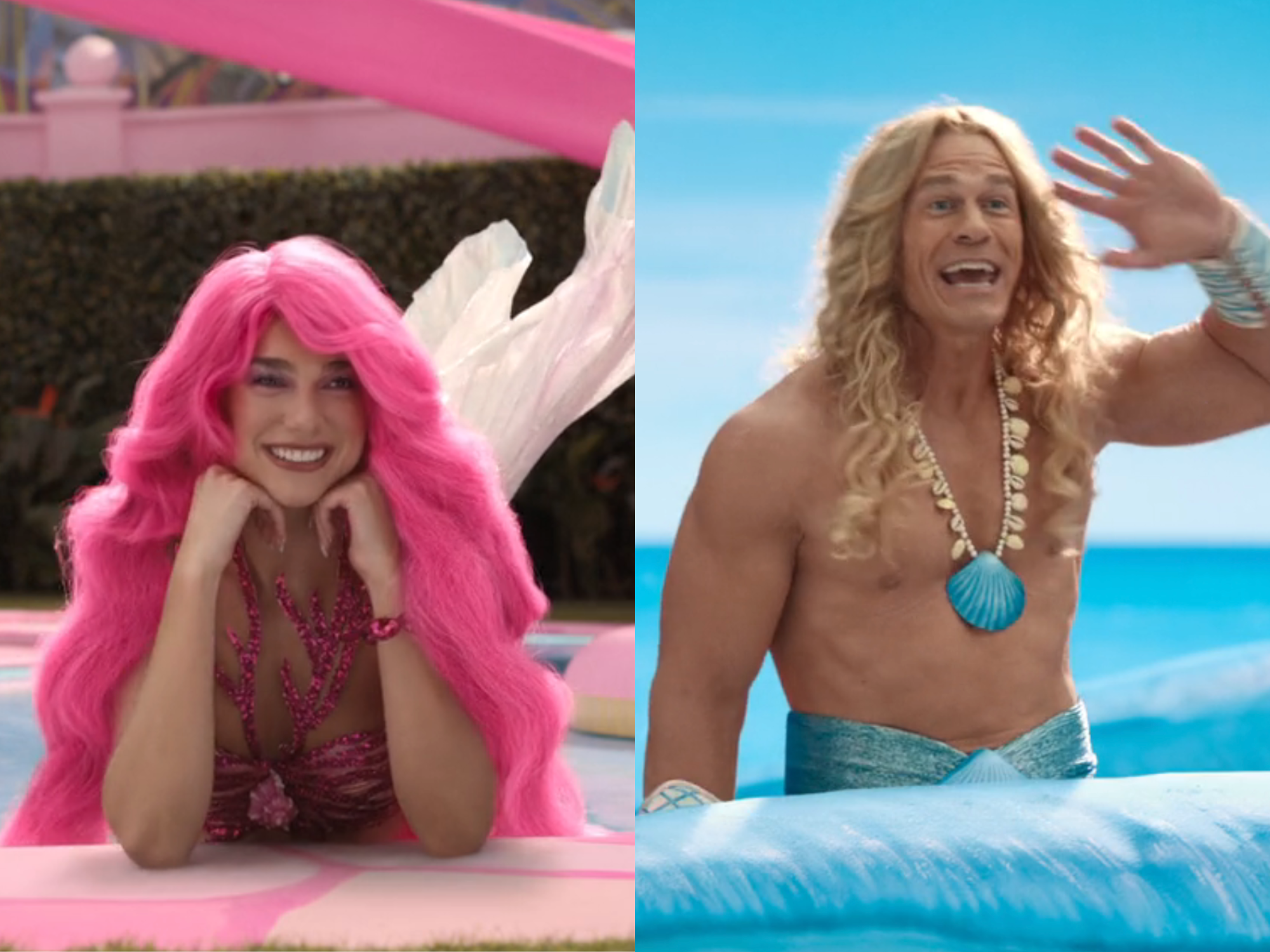
Dua Lipa and John Cena have cameos as Mermaid Barbie and Merman Ken.
Dua Lipa pulls double duty for "Barbie," as a character in the film and an artist on the soundtrack, with the disco-pop song "Dance the Night."
She first appears as three Mermaid Barbies with different hair colors during the beach scene where the Barbies greet Robbie's character during another perfect day in Barbie Land. She shows up later in the film, too.
When the Kens take over Barbie Land, John Cena also makes a cameo as a Merman Ken, whom Mermaid Barbie gives a beer to. With his long, wavy blonde hair, the wrestler-turned-actor is unrecognizable.
He's also seen playing ukulele during a scene when the Kens serenade their Barbies by performing Matchbox Twenty's "Push."
Warner Bros.
-
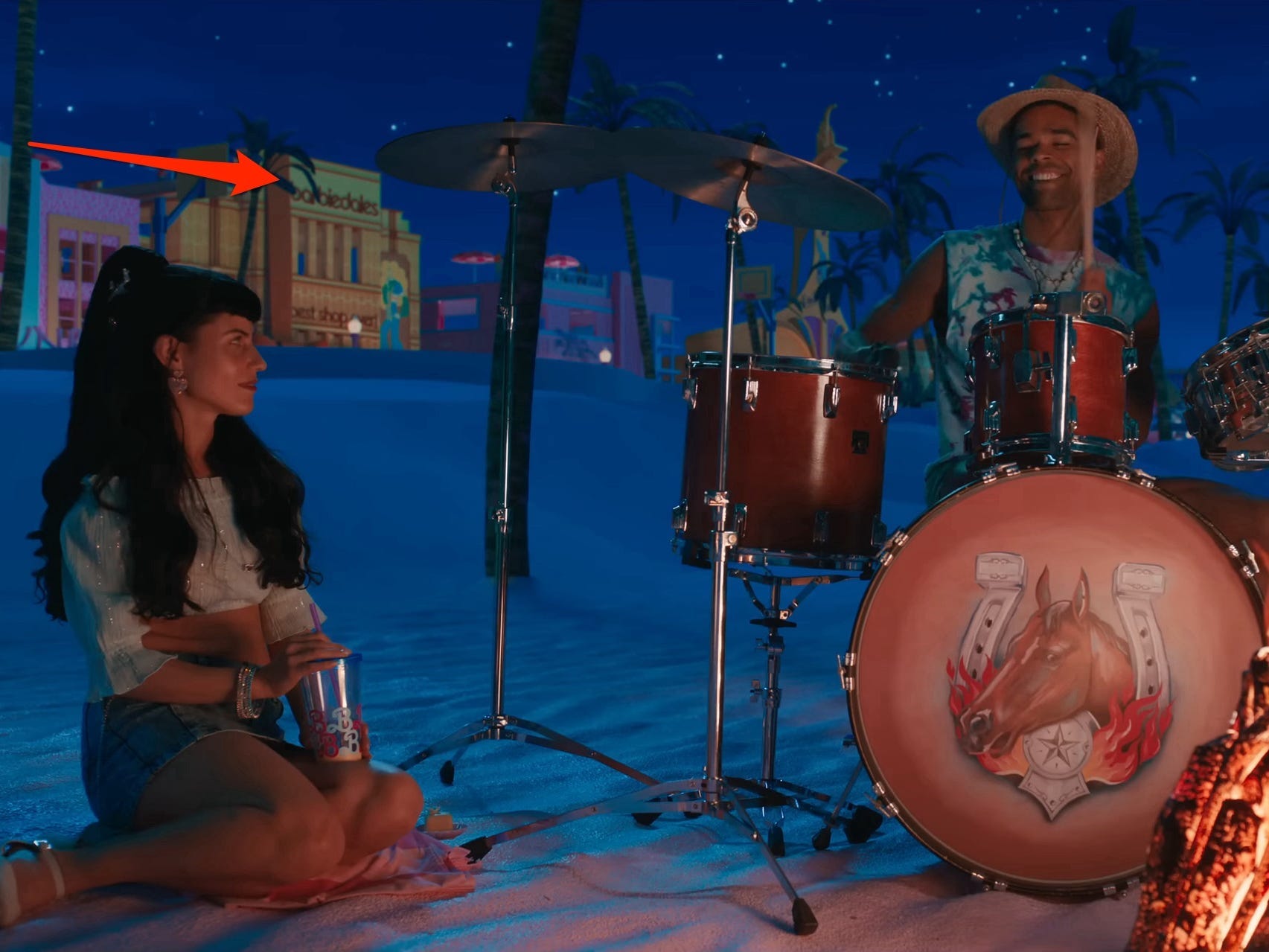
Barbie Land has its own version of Bloomingdale's called Barbiedale's.
The store can be seen in a few shots of the film, like when Stereotypical Barbie drives through the land and when the Kens serenade the Barbies.
Warner Bros.
-
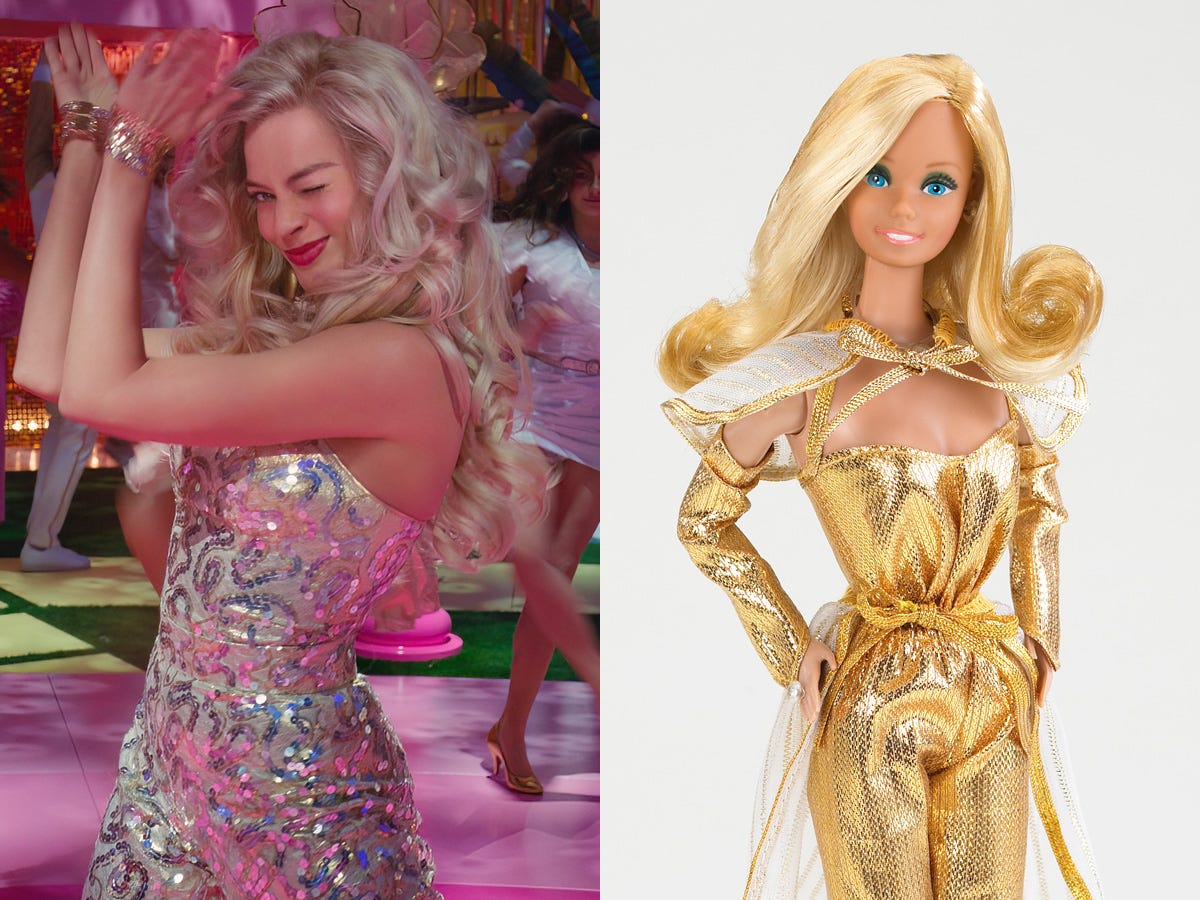
Stereotypical Barbie's gold disco jumpsuit is reminiscent of the 1980 Golden Dreams Barbie.
Barbie wears the outfit during a dance sequence as part of her blowout party.
Warner Bros.; Mattel
-
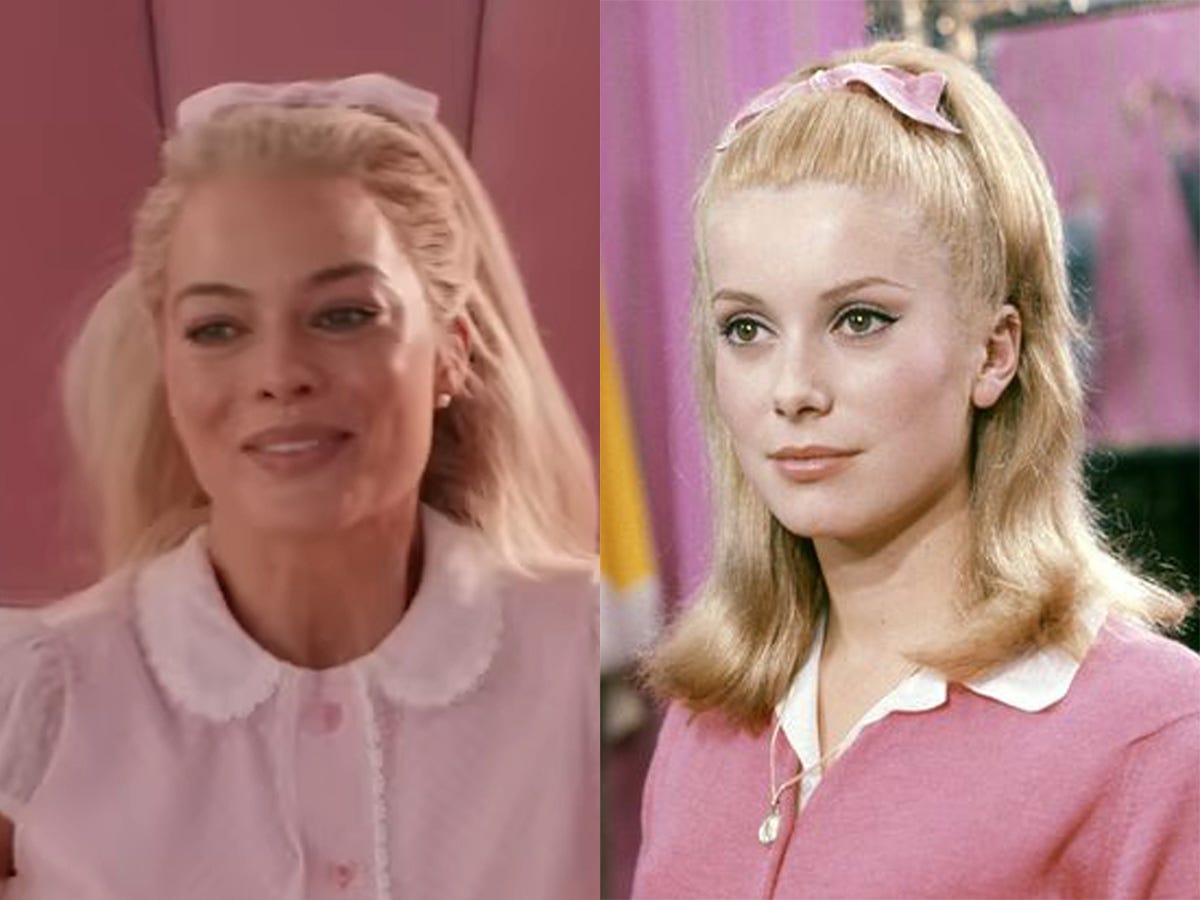
Stereotypical Barbie's hairstyle early in the movie is a nod to the 1964 movie "The Umbrellas of Cherbourg."
Gerwig told Letterboxd that Robbie's hair being accessorized by a pink bow in the scene where she goes to bed and wakes up the next morning was "definitely a nod to that Catherine Deneuve hair" in "The Umbrellas of Cherbourg."
Warner Bros.; 20th Century Fox
-
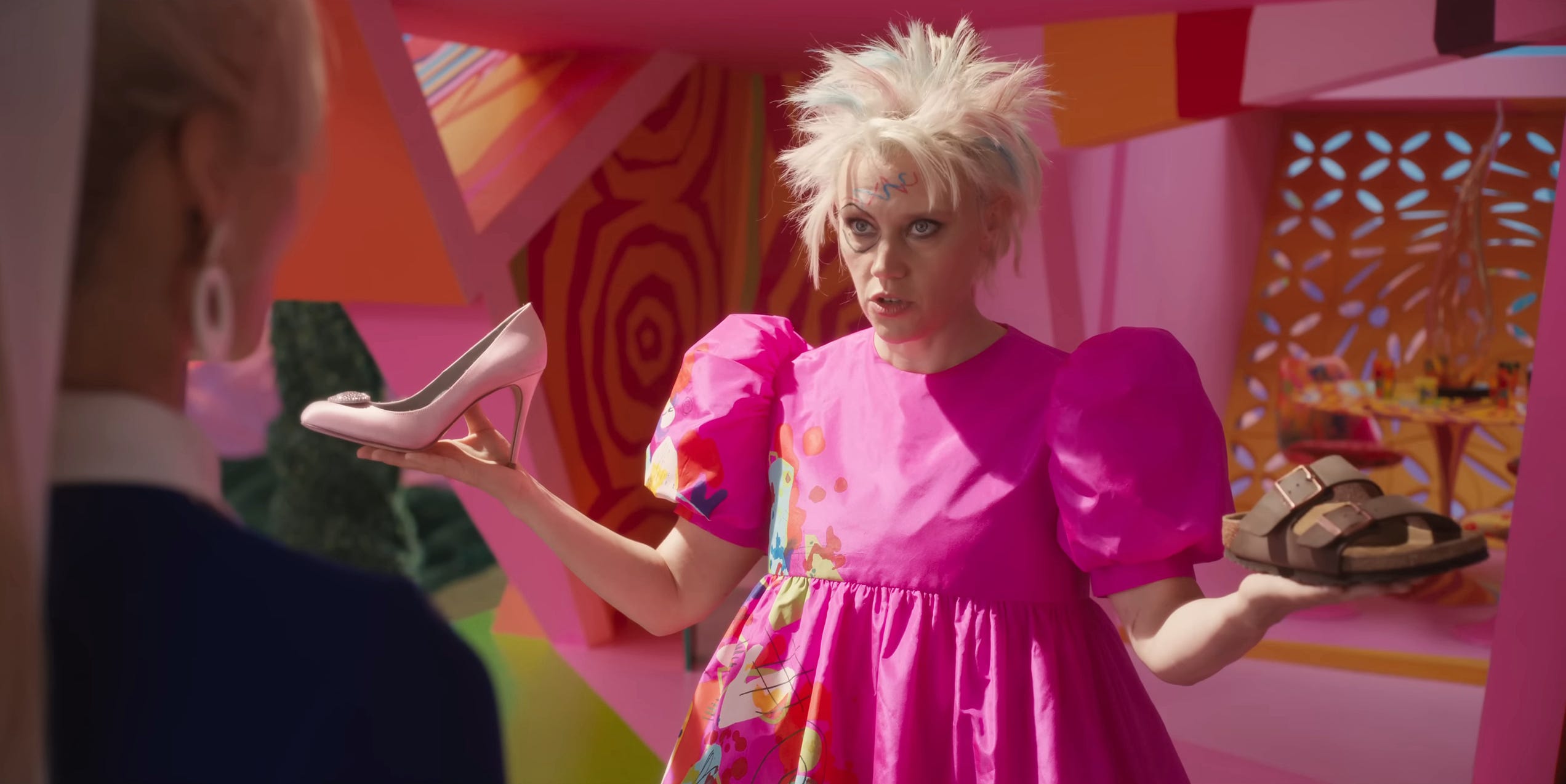
Weird Barbie making Stereotypical Barbie choose between the pink high heel and the Birkenstock is a nod to "The Matrix."
When Stereotypical Barbie goes to Weird Barbie (Kate McKinnon) for help after she begins malfunctioning, the doll tells her she has to go to the real world and find out what is wrong with her human counterpart or it could mean doom for both worlds.
She then gives Stereotypical Barbie a choice, using a pink heel and brown Birkenstock sandal to demonstrate. Stereotypical Barbie can either go back to how everything was before (heel) or find out the truth (Birkenstock).
In "The Matrix," the lead character, Neo, is also given the option to learn about the reality of the universe or go back to his ordinary life, but the choice is presented through a blue pill and a red pill.
Warner Bros.
-
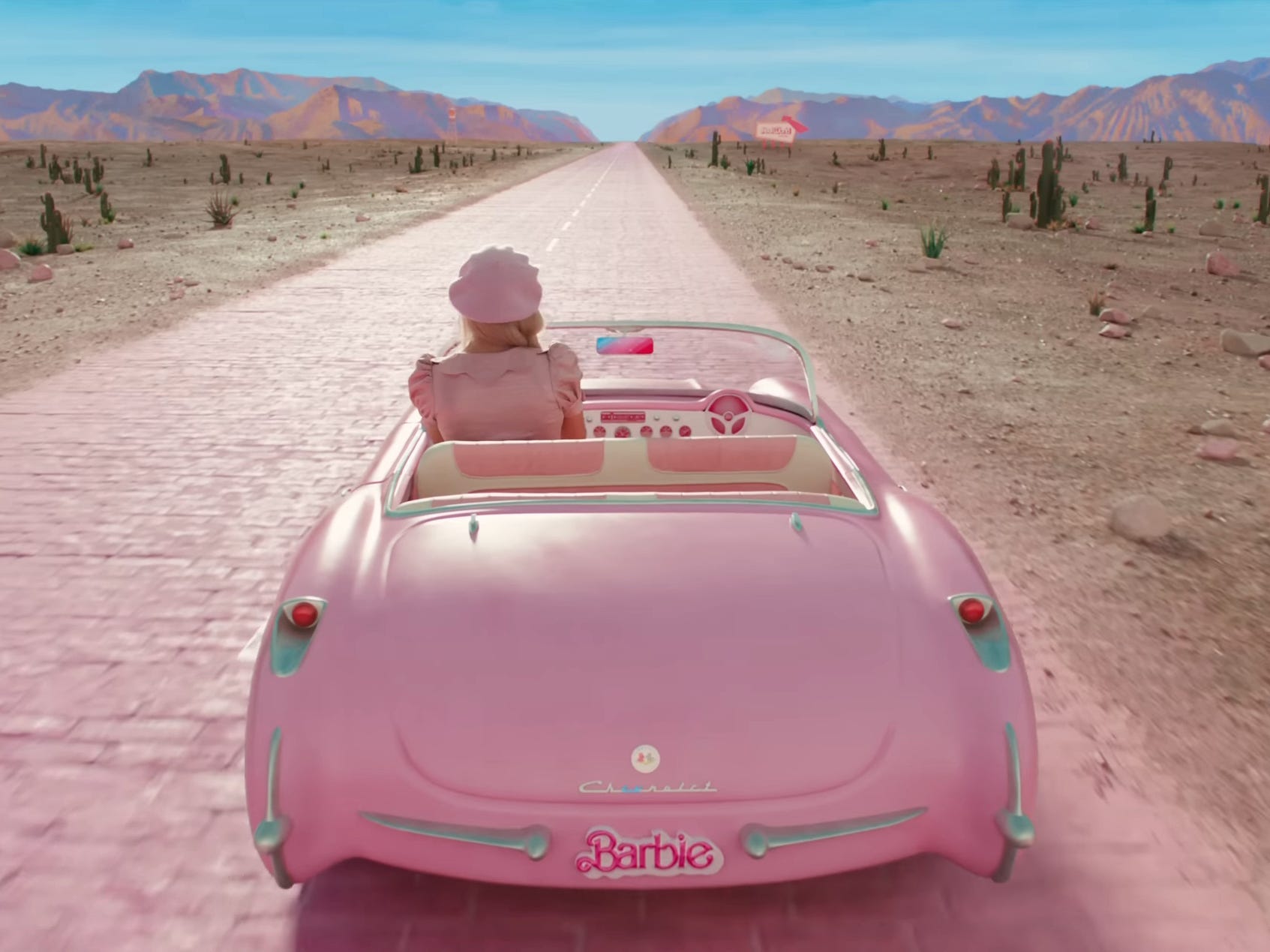
To leave Barbie Land, Robbie's character must drive along a pastel-pink-brick road.
This is reminiscent of the yellow-brick road from "The Wizard of Oz."
Gerwig told Letterboxd that the aesthetic of the aforementioned film informed the design of Barbie Land.
Warner Bros.
-
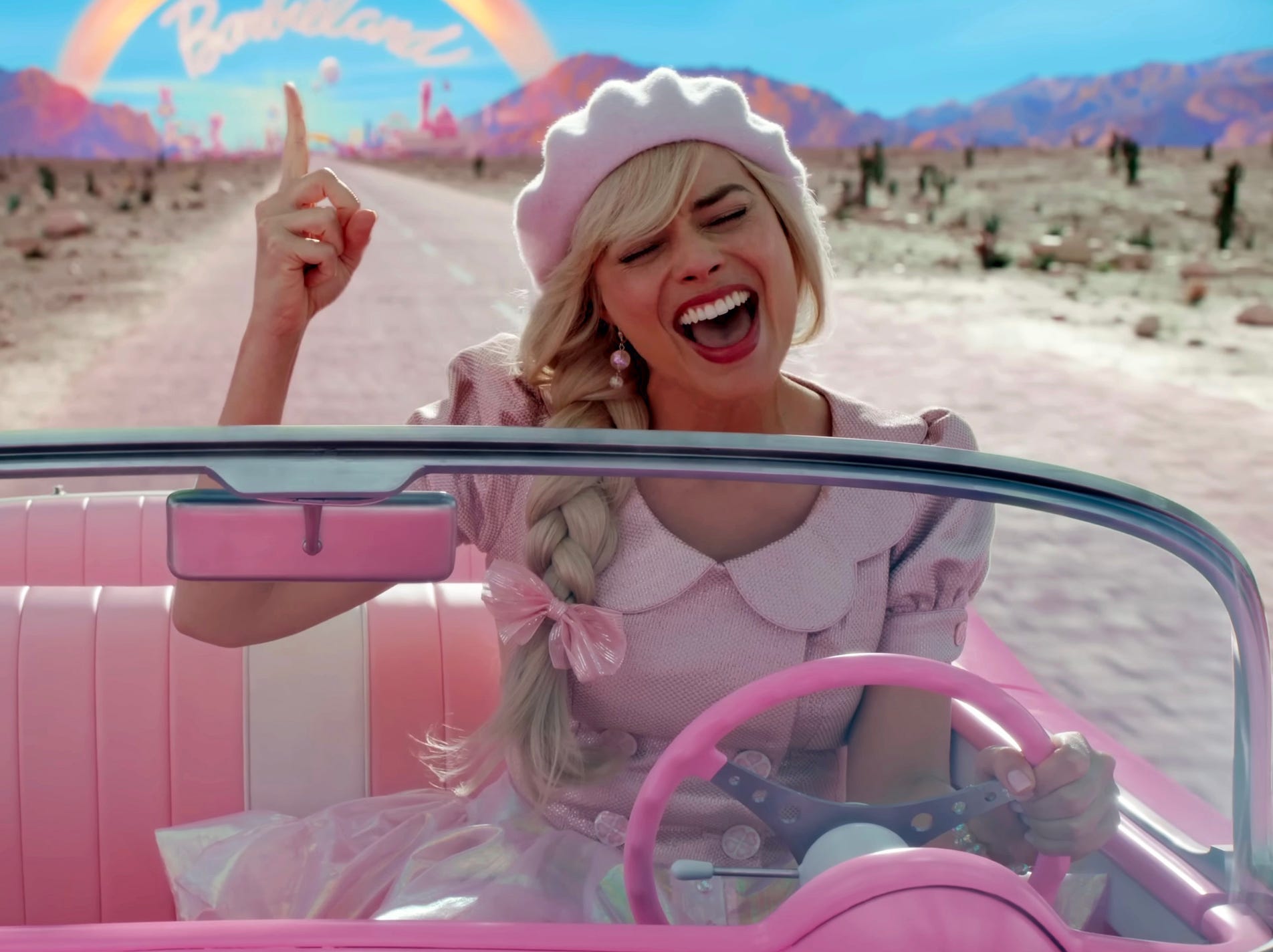
Barbie Land's anthem is Indigo Girls' "Close to Fine."
In Barbie Land, there's only one song playing on the radio, "Close to Fine" by Indigo Girls.
The song is about accepting that life's biggest philosophical questions may not have one definitive answer and the search to find those answers.
This is crucial to Stereotypical Barbie's journey as she is trying to find out why she's malfunctioning. In doing so, she gets a complicated answer.
Warner Bros.
-
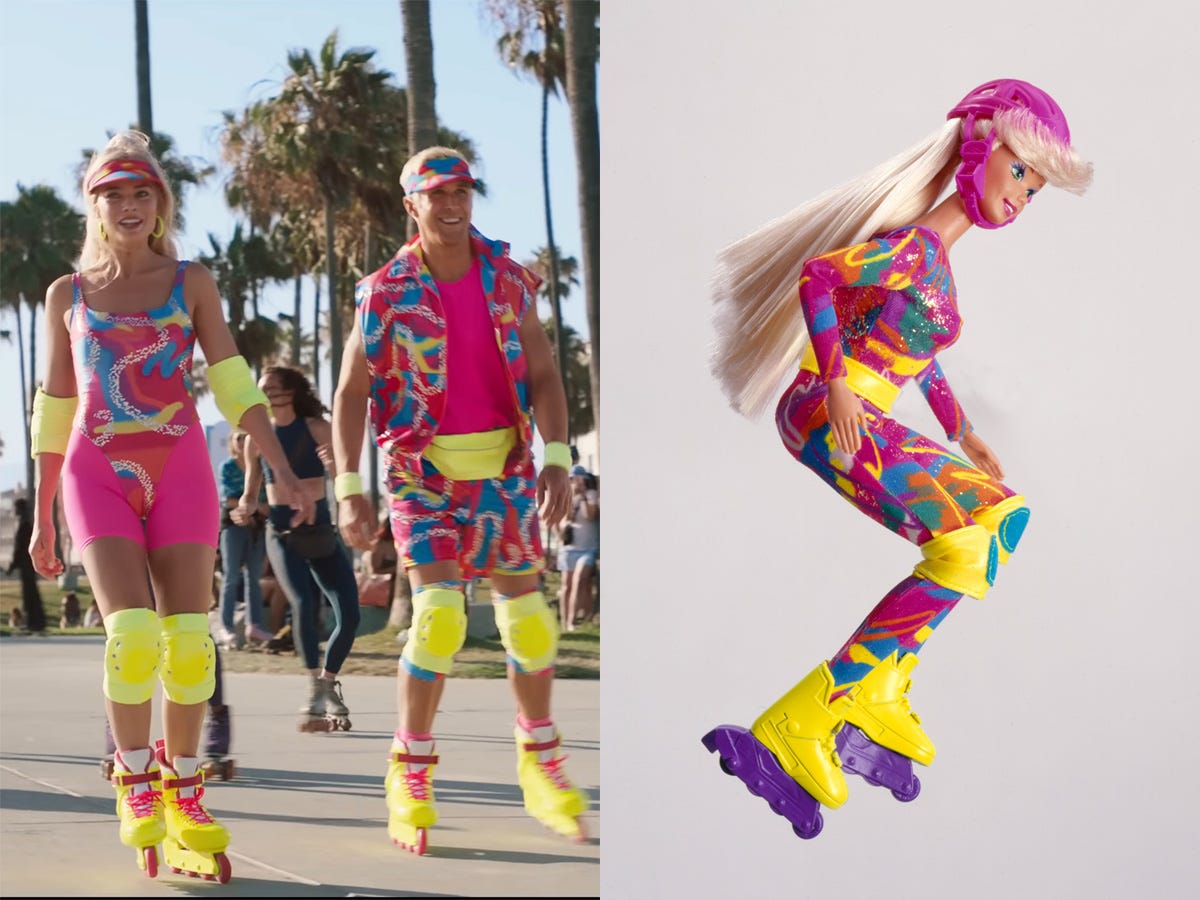
Barbie and Ken's neon outfits worn in Venice Beach are likely inspired by the 1994 Hot Skatin Barbie.
Barbie and Ken change into cowboy and cowgirl outfits after noticing people staring at their bright ensembles.
Warner Bros.
-
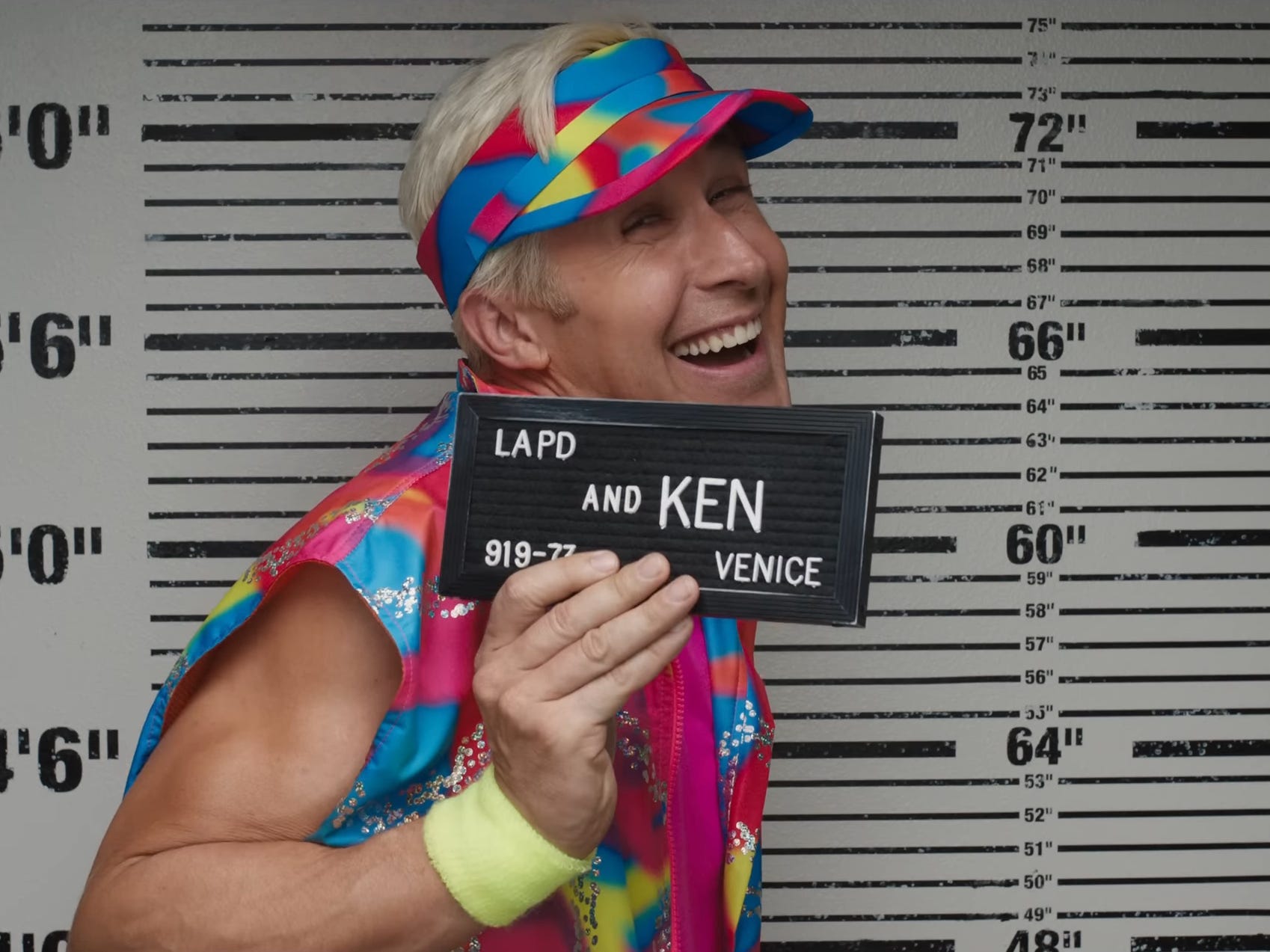
Ken's legal name in the real world is "and Ken."
When Stereotypical Barbie and Ken get arrested, the latter character's name on the mugshot board reads "and Ken."
It is very likely that Ken thinks his name is "and Ken" because he's always been referenced in relation to Barbie as the duo "Barbie and Ken."
Warner Bros.
-
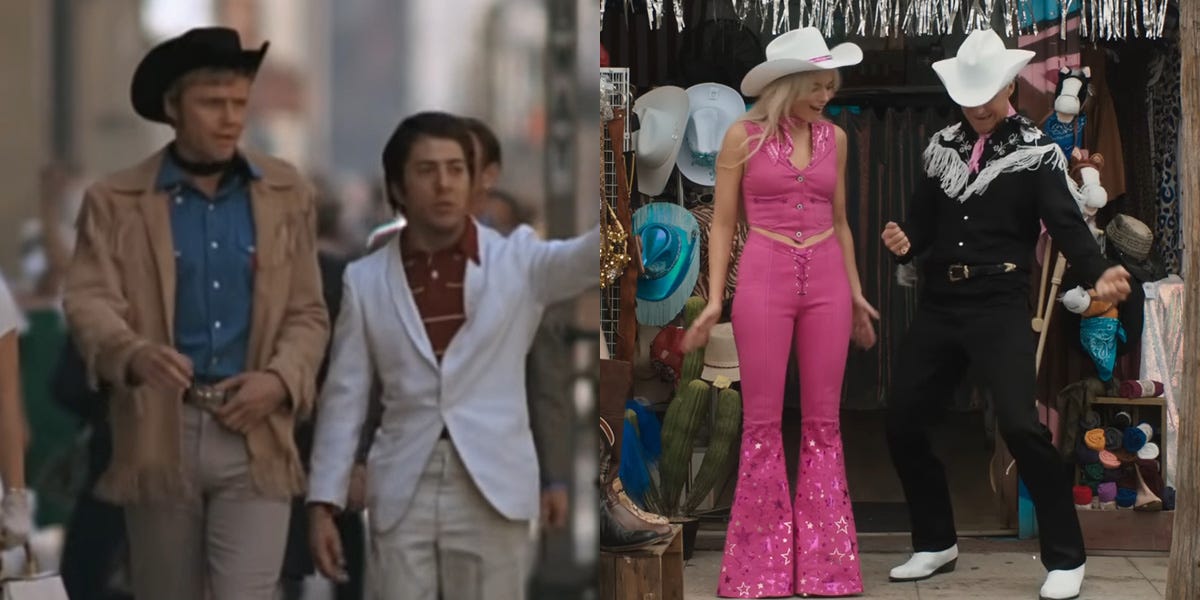
Barbie and Ken's arrival (and displacement) in the real world pays homage to a scene from "Midnight Cowboy."
According to the "Barbie" press notes, Gerwig wanted Barbie and Ken to mirror the fish-out-of-water experience Jon Voight's "Midnight Cowboy" character has when he walks through New York City in the 1969 movie.
United Artists; Warner Bros.
-
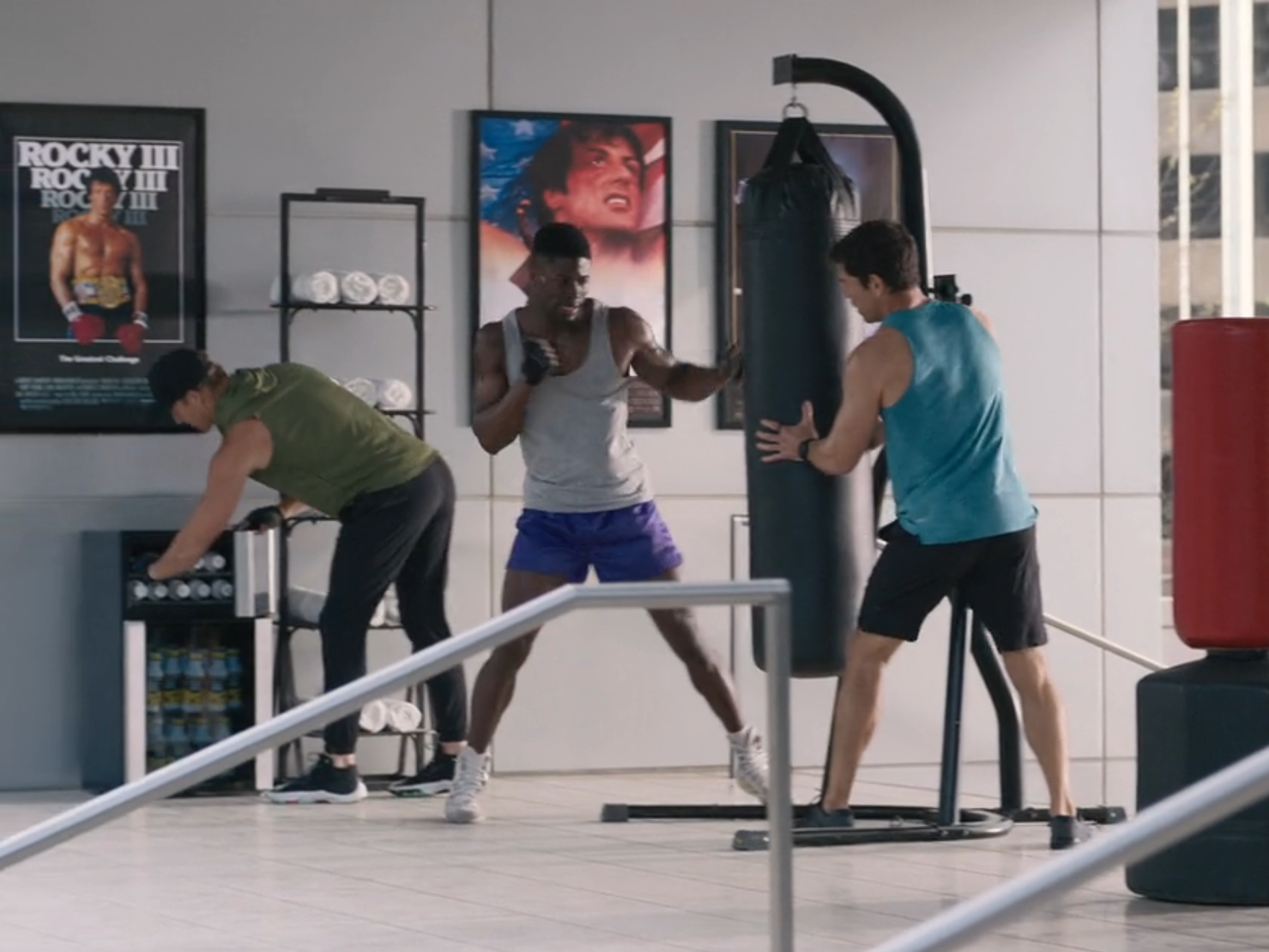
Sylvester Stallone represents manly men in the "Barbie" movie.
When Ken arrives in the real world, he learns about the patriarchy and how masculine men rule the real world.
One of the repeated symbols of this masculinity is Sylvester Stallone, first through posters in a gym in Century City showing the actor's famous "Rocky" character.
Then during the masculinity montage, Stallone is seen in fur coats, which Ken replicates when he returns to Barbie Land.
Ken is also wearing boxing gloves when we first see him in Barbie Land after he learns about the patriarchy.
Ken also loves horses, similar to the real Stallone.
Warner Bros.
-
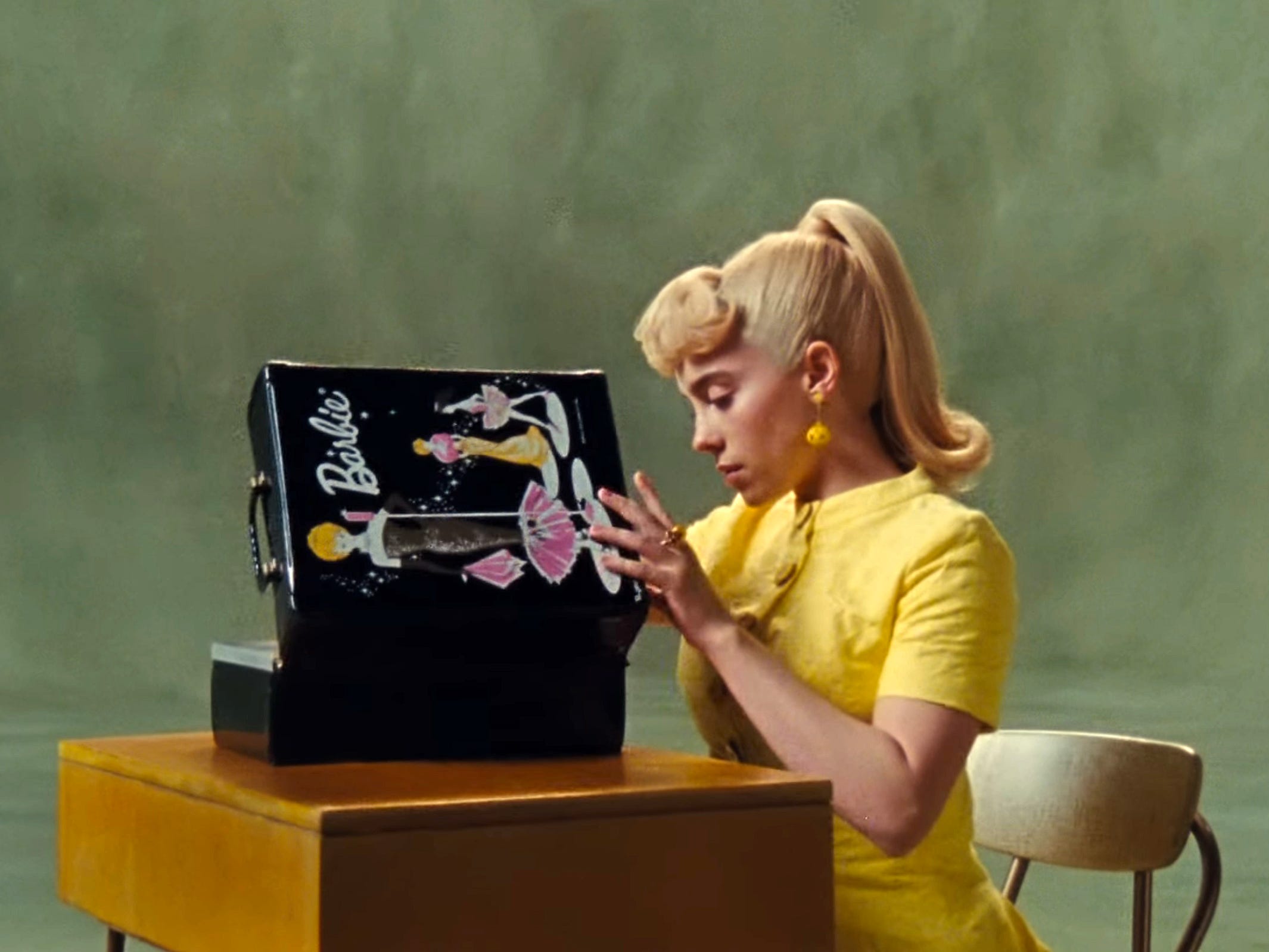
Billie Eilish's "What Was I Made For" is a recurring theme in "Barbie."
The instrumental for Eilish's song "What Was I Made For" is first used when Stereotypical Barbie watches humans in the real world for the first time.
The melody is repeated on two other occasions – when Stereotypical Barbie meets her creator Ruth Handler (Rhea Perlman) and right at the end when Stereotypical Barbie chooses to be human and live in the real world. In the latter instance, a different version of the song plays.
The song's lyrics are mostly about the singer finding her purpose, so the repeated theme seems to align with key moments where Stereotypical Barbie finds out what she wants in life.
Billie Eilish/YouTube
-
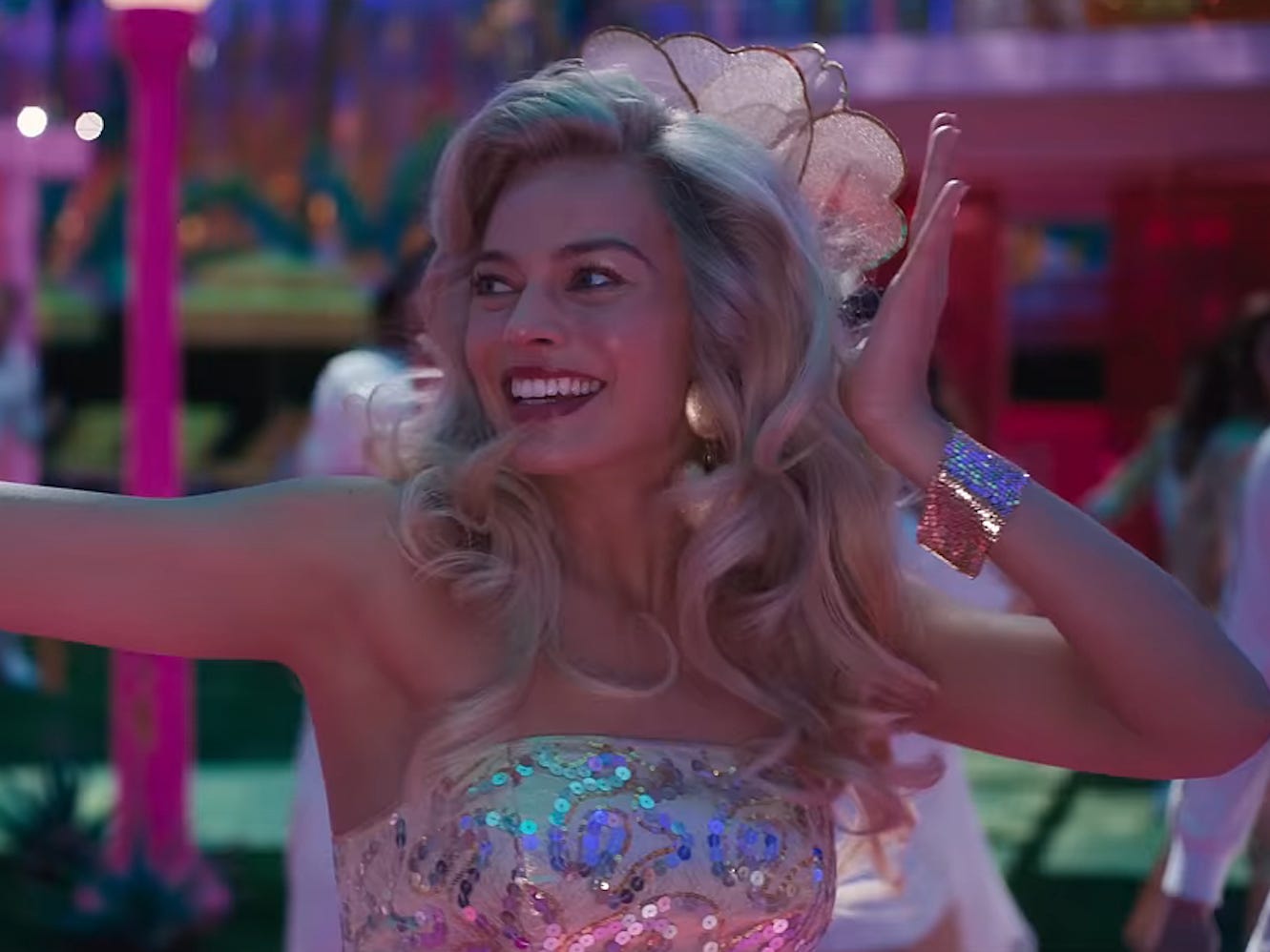
The string lick from Dua Lipa's soundtrack song "Dance the Night" is also repeated several times during the film.
Most notably, it's played when the title card shows for the first time, and in scenes involving the Mattel goons.
Warner Bros.
-
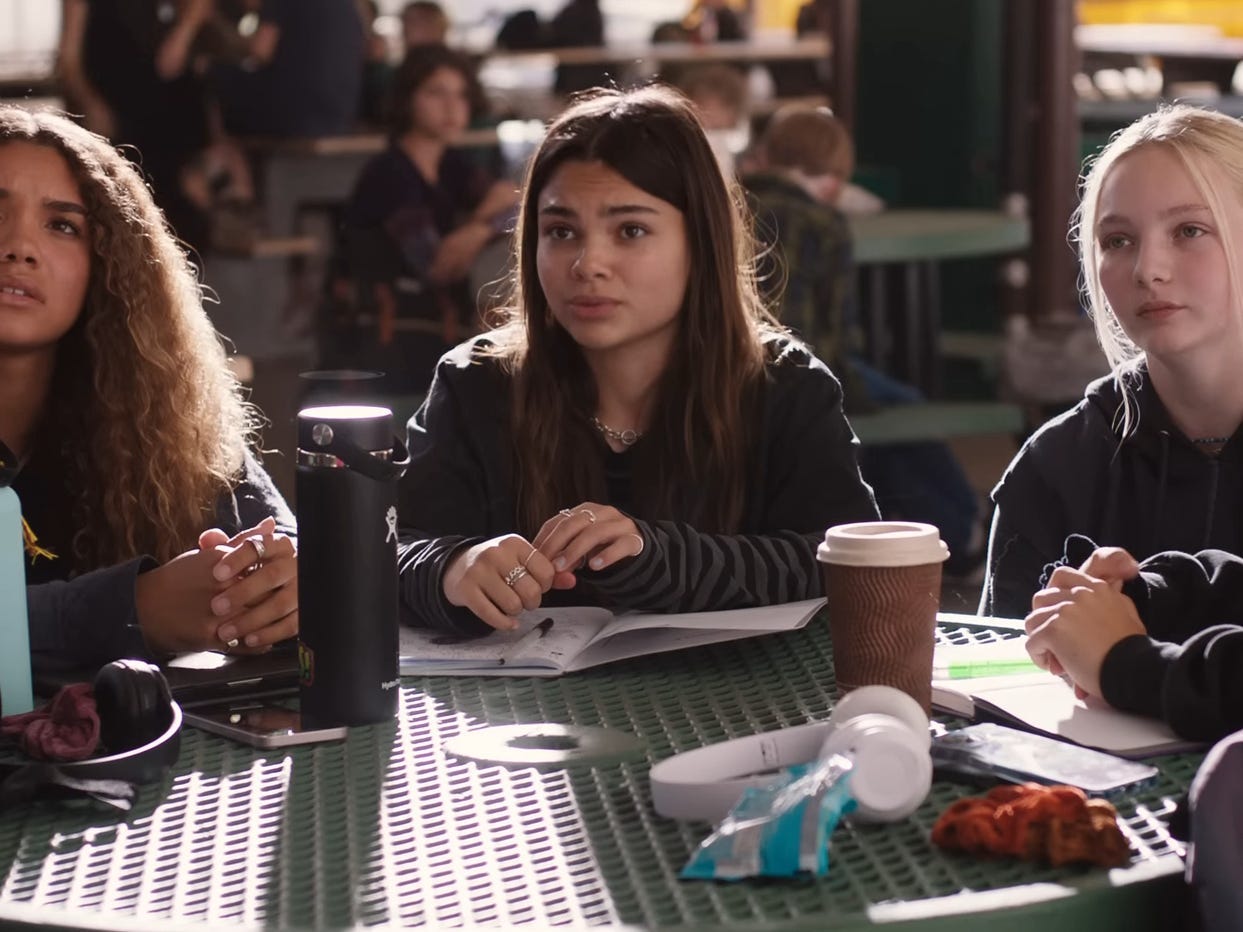
Gloria's daughter, Sasha, shares a name with one of the original Bratz dolls.
In the real world, Stereotypical Barbie tries to fix the rift between the two worlds by locating her owner, the girl who first bought her doll.
She assumes it's a girl named Sasha (Ariana Greenblatt), which leads her to the teenager's school, Davy Crockett Junior High School.
Sasha shares a name with one of the original Bratz dolls (a longtime Barbie rival), and her friends also resemble Cloe, Jade, and Yasmin, the other members of the original line.
Gloria also refers to Sasha at one point as "bunny boo" — which is also Bratz Sasha's nickname.
Warner Bros.
-
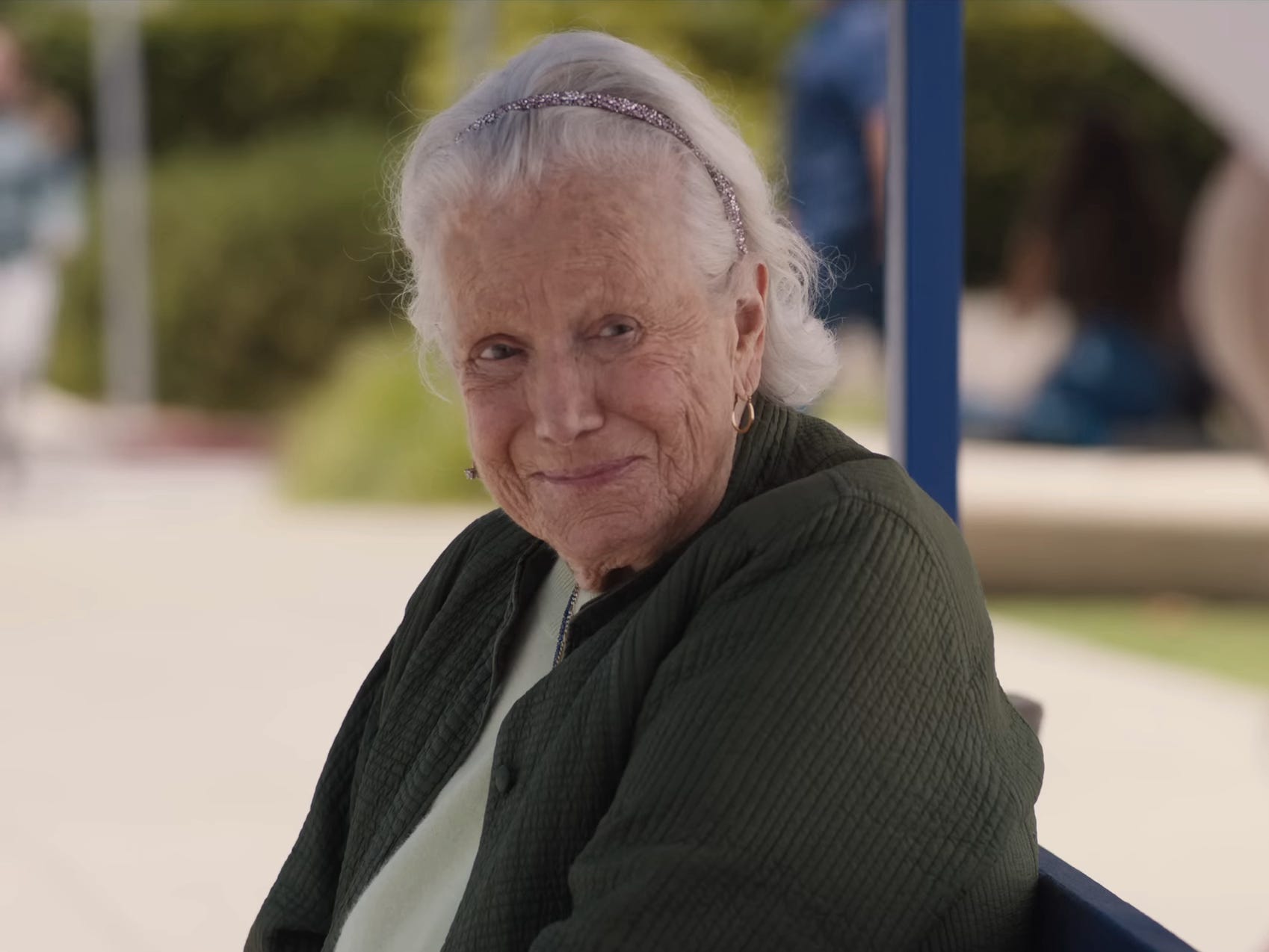
Oscar-winning costume designer Ann Roth, who's a friend of Gerwig, has a cameo.
While observing the humans, Stereotypical Barbie meets a random older woman next to her on a bench, whom she calls beautiful. It's seemingly the first time Barbie has ever seen an elderly person.
The character is played by Ann Roth, an Oscar-winning costume designer and a friend of Gerwig, according to the New York Times.
Warner Bros.
-
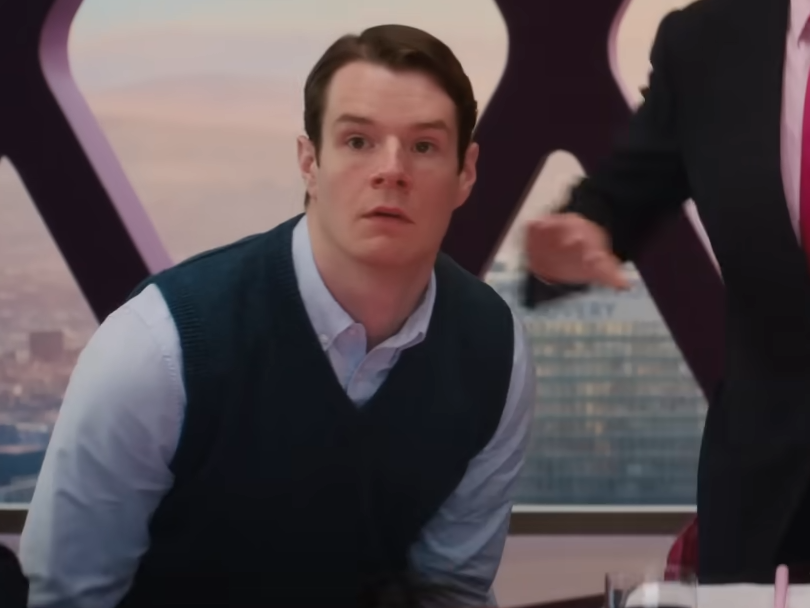
Aaron Dinkins is the only Mattel employee whose name is stated in the movie.
Numerous scenes occur at the Mattel headquarters in California.
While there are multiple Mattel employees, including Will Ferrell's Mattel CEO, none of their names are revealed except for the lowly intern, Aaron Dinkins (played by "Sex Education" star Connor Swindells), who informs the company about the rogue Barbie.
Warner Bros.
-
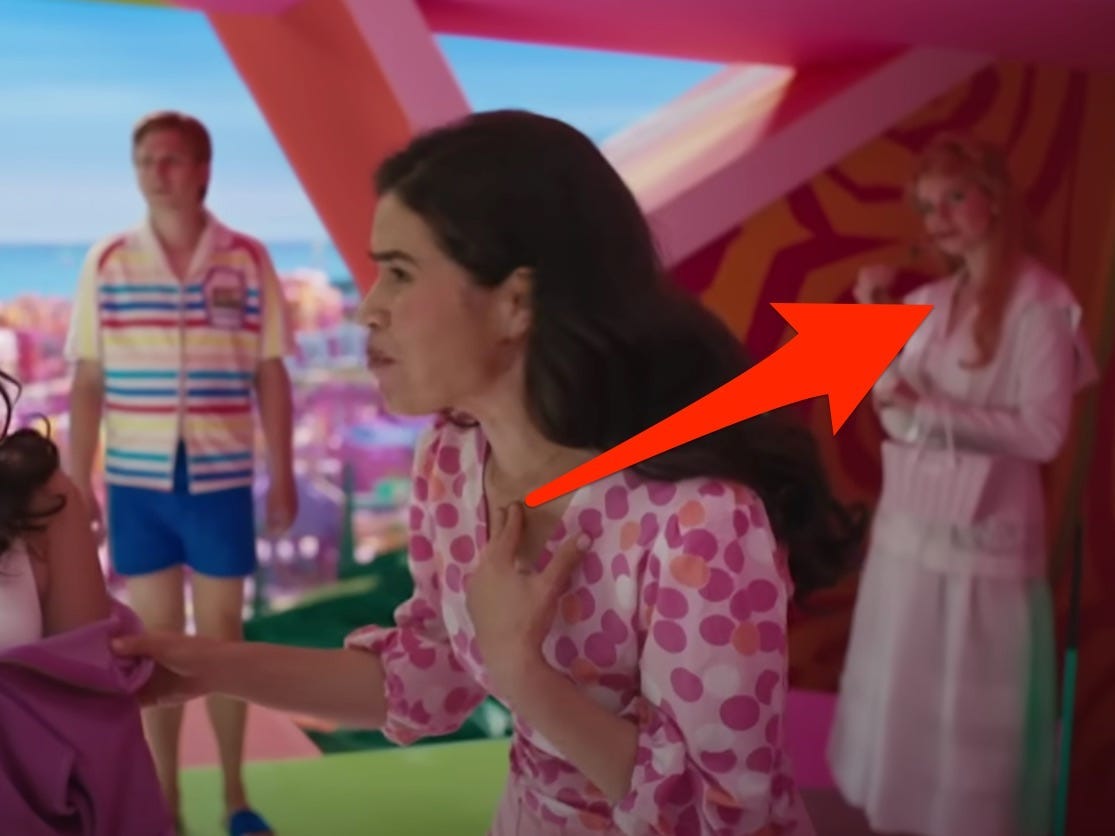
The Mattel CEO makes a reference to Proust Barbie, who is later portrayed by Lucy Boynton.
Marcel Proust was a famous 20th-century French author that wrote about love, art, time, memory, and the meaning of living — all of which are topics Stereotypical Barbie learns about through her journey to the real world.
When Stereotypical Barbie steps inside the large plastic box at the Mattel office, she mentions how the smell of the box brought up a Proustian memory. Ferrell's CEO character then makes the comment, "Remember Proust Barbie? That did not sell well."
Gerwig told The Hollywood Reporter that the moment is a nod to Proust's work.
"In 'Remembrance of Things Past,' in 'Swann's Way,' he is literally thrown back into his childhood through the taste of the madeleine," Gerwig told THR. "I thought, well, that'll be a nice Easter egg for one person."
Proust Barbie actually does make a brief cameo later in the movie at Weird Barbie's house, played by "Bohemian Rhapsody" star Lucy Boynton.
Warner Bros.
-
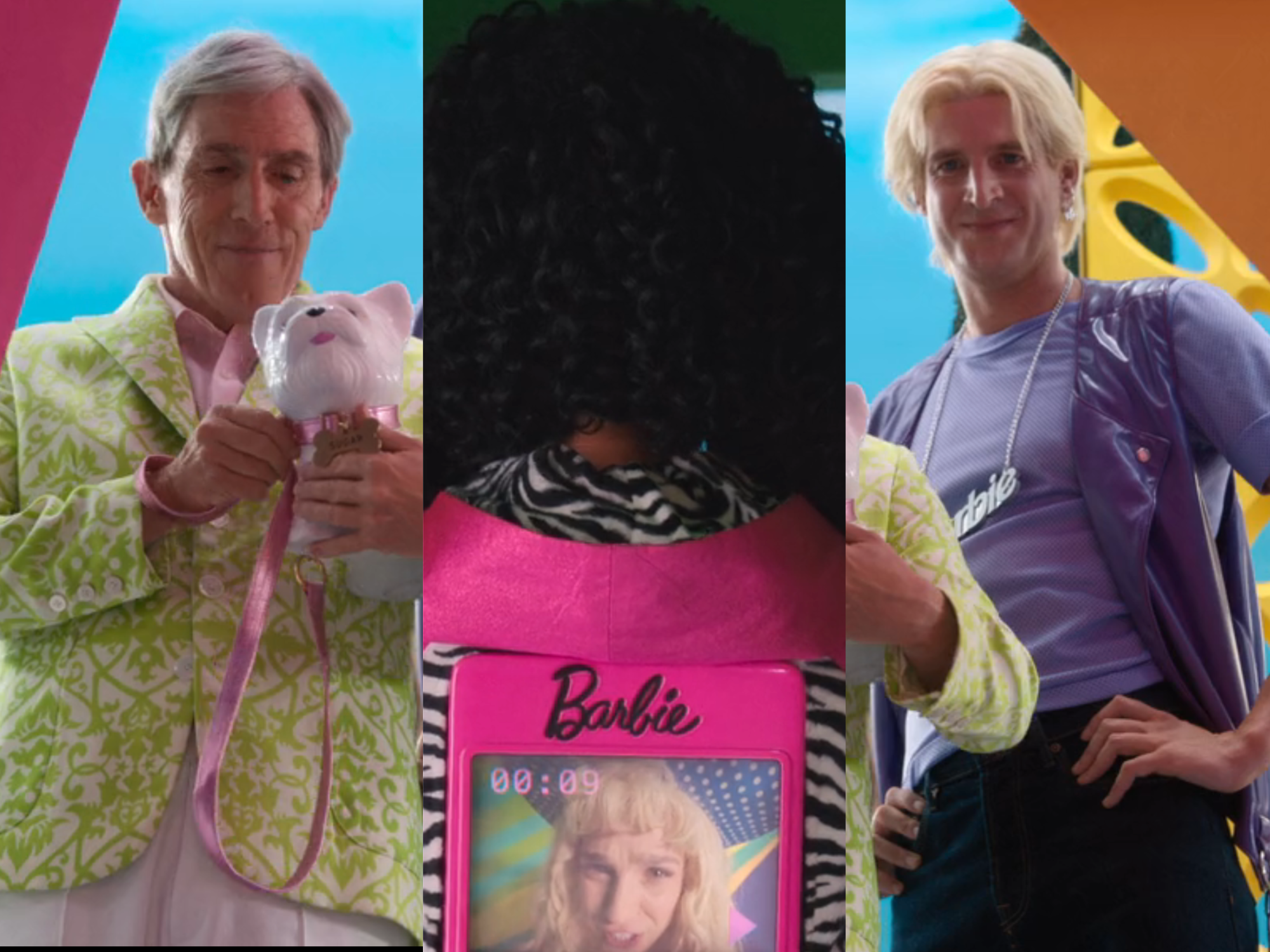
A bunch of Mattel's discontinued dolls have cameos at Weird Barbie's house.
Growing Up Skipper, Earring Magic Ken, Sugar Daddy Ken, and Video Girl Barbie all pop up late in the film.
Warner Bros.
-
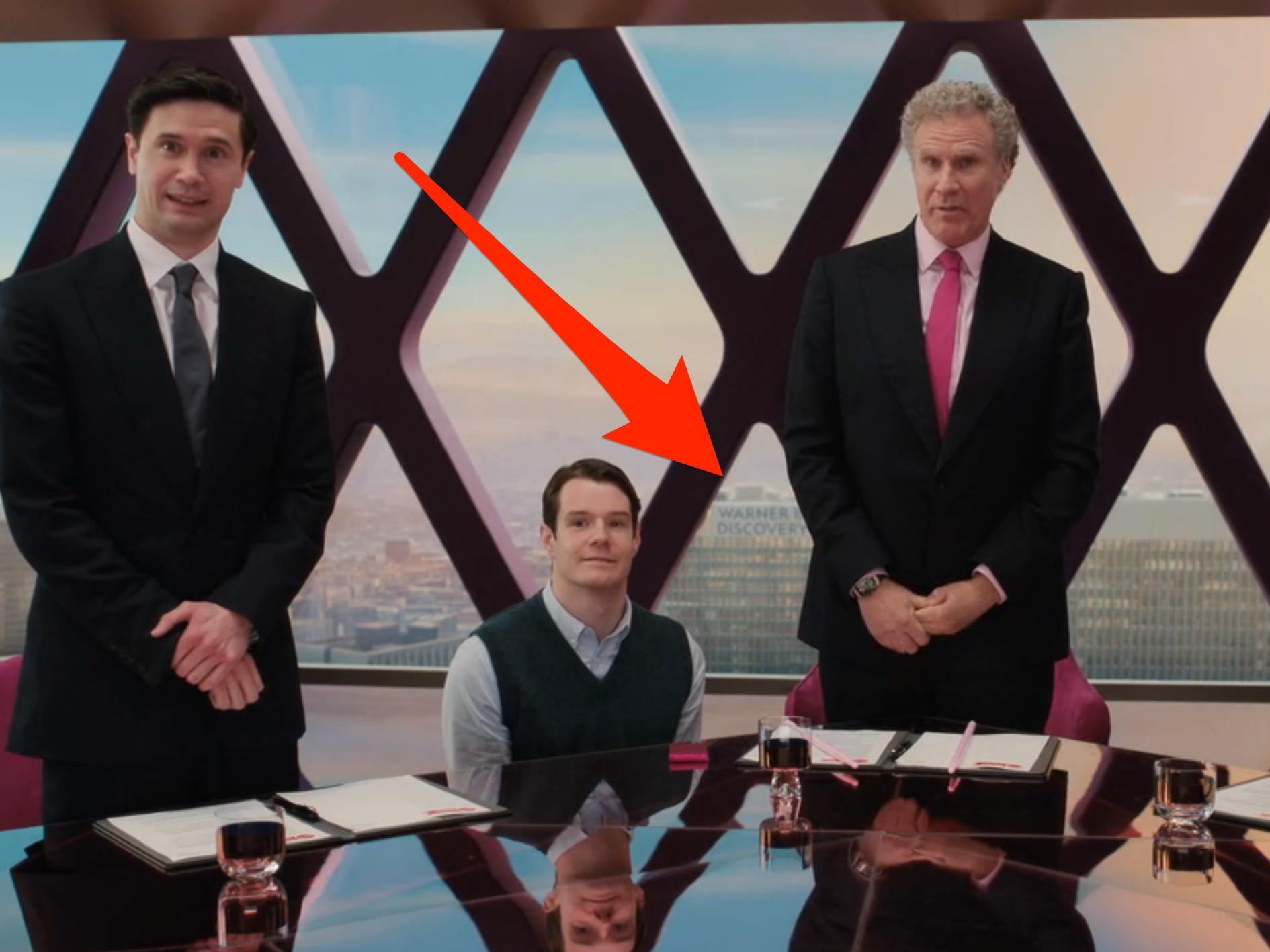
There's a Warner Bros. Discovery building in the background of the Mattel headquarters.
Warner Bros. Discovery is the studio that produced the film.
At one point, when Mattel is reacting to the chaos of the Kens taking over Barbie Land, a Mattel employee says that Warner Bros. had decided to make a movie about Ken.
There's also a reference to Zack Snyder's cut of "Justice League," which was distributed by Warner Bros.
Warner Bros.
-
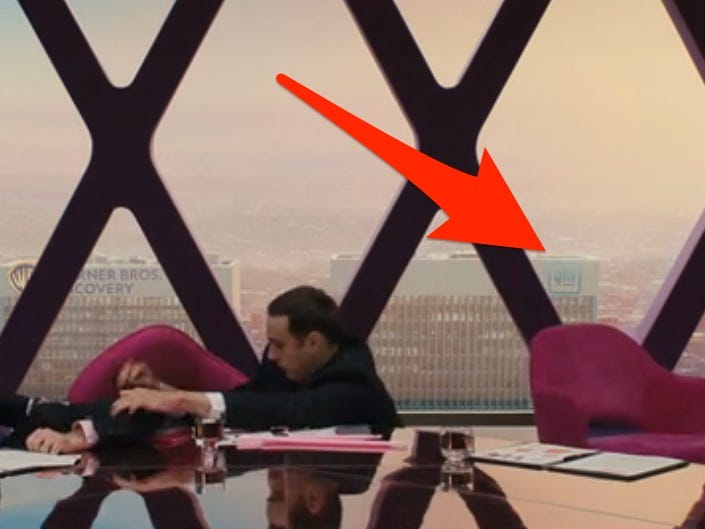
There's also a General Motors building nearby the Warner Bros. Discovery building.
All of the vehicles used during the chase scene are General Motors.
In the film, Ken drives a Hummer, and Barbie's pink convertible was inspired by a classic Chevy vehicle.
Warner Bros.
-
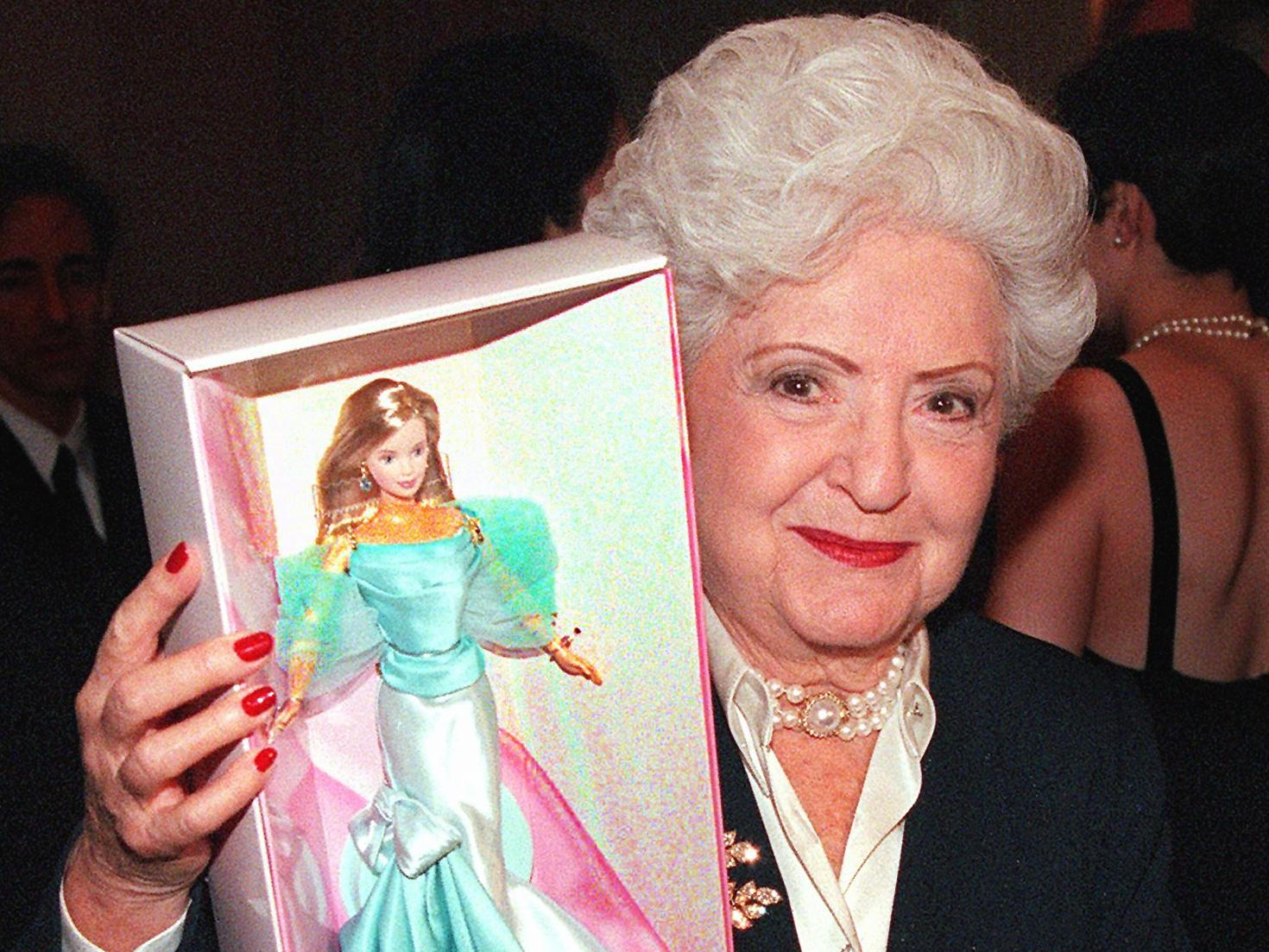
Rhea Perlman, who appears as Ruth Handler, makes meta jokes about the real-life Barbie creator.
As Stereotypical Barbie tries to escape from Mattel HQ, she stumbles into a room where she finds an older lady (Rhea Perlman).
While she doesn't reveal herself as Barbie's creator Ruth Handler until much later, there are numerous hints about her identity.
Firstly, the fictional Ruth makes a joke about tax evasion, which is a reference to the real Handler, who was indicted on charges of false reporting to the Securities and Exchange Commission and fraud in 1978.
On the table that the fictional Handler is sitting at, there's a pink cloth that's similar to the pink gingham dress that Stereotypical Barbie wears earlier in the movie.
When Handler returns at the end of the movie, she makes more references to her real-life counterpart's history, such as getting a mastectomy. The real Handler also got a mastectomy after being diagnosed with breast cancer in 1970, according to People.
Matt Campbell/AFP/Getty Images
-
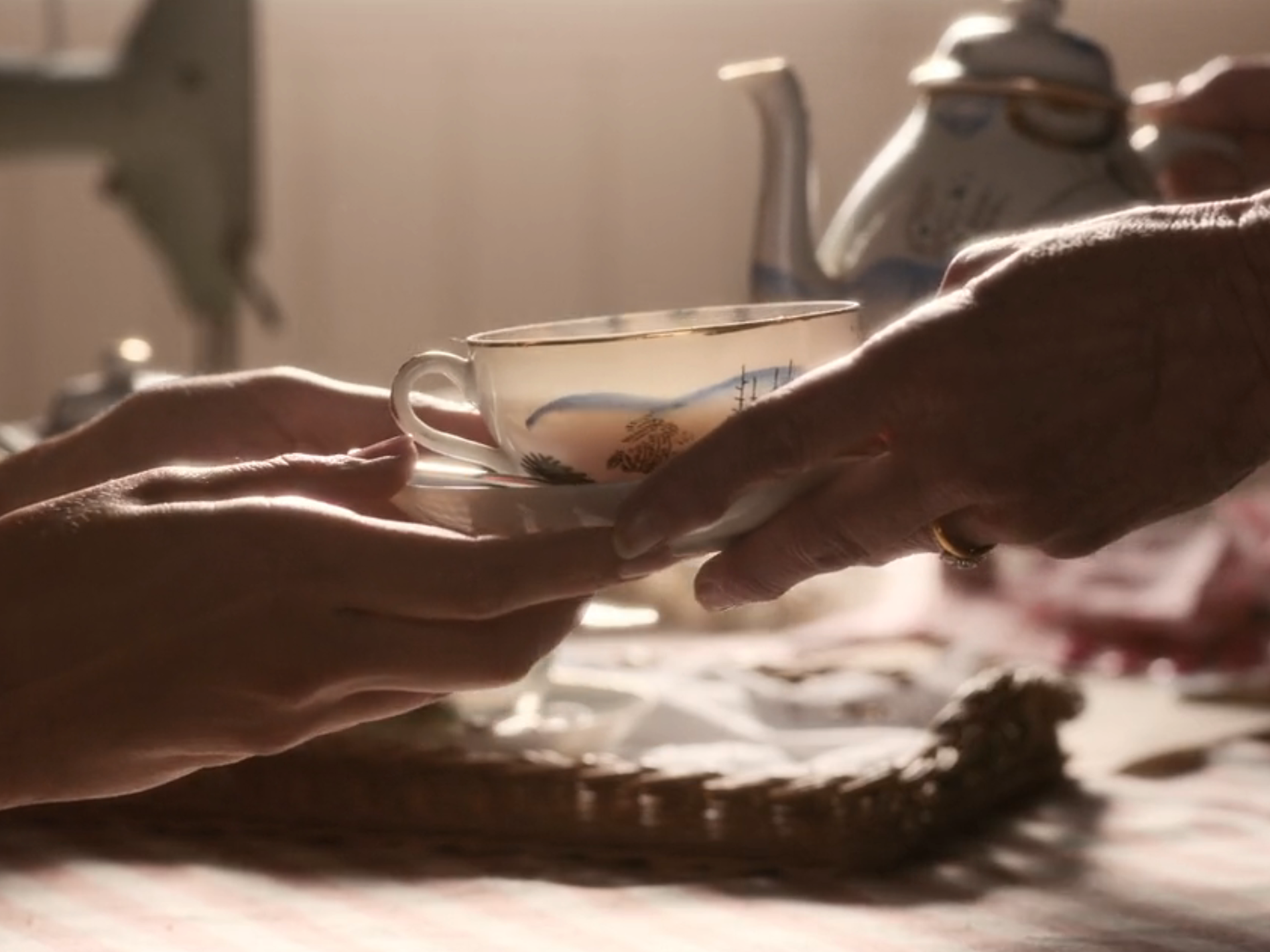
A scene involving Ruth and Barbie mimics Michelangelo's famous painting "The Creation of Adam."
Barbie and Ruth's hands emulate the painting when the doll creator hands her a cup of tea.
"It's on the same trajectory and angle as the Sistine Chapel," Gerwig told Time magazine. "Nobody is going to notice that so I have to say it."
Warner Bros.
-
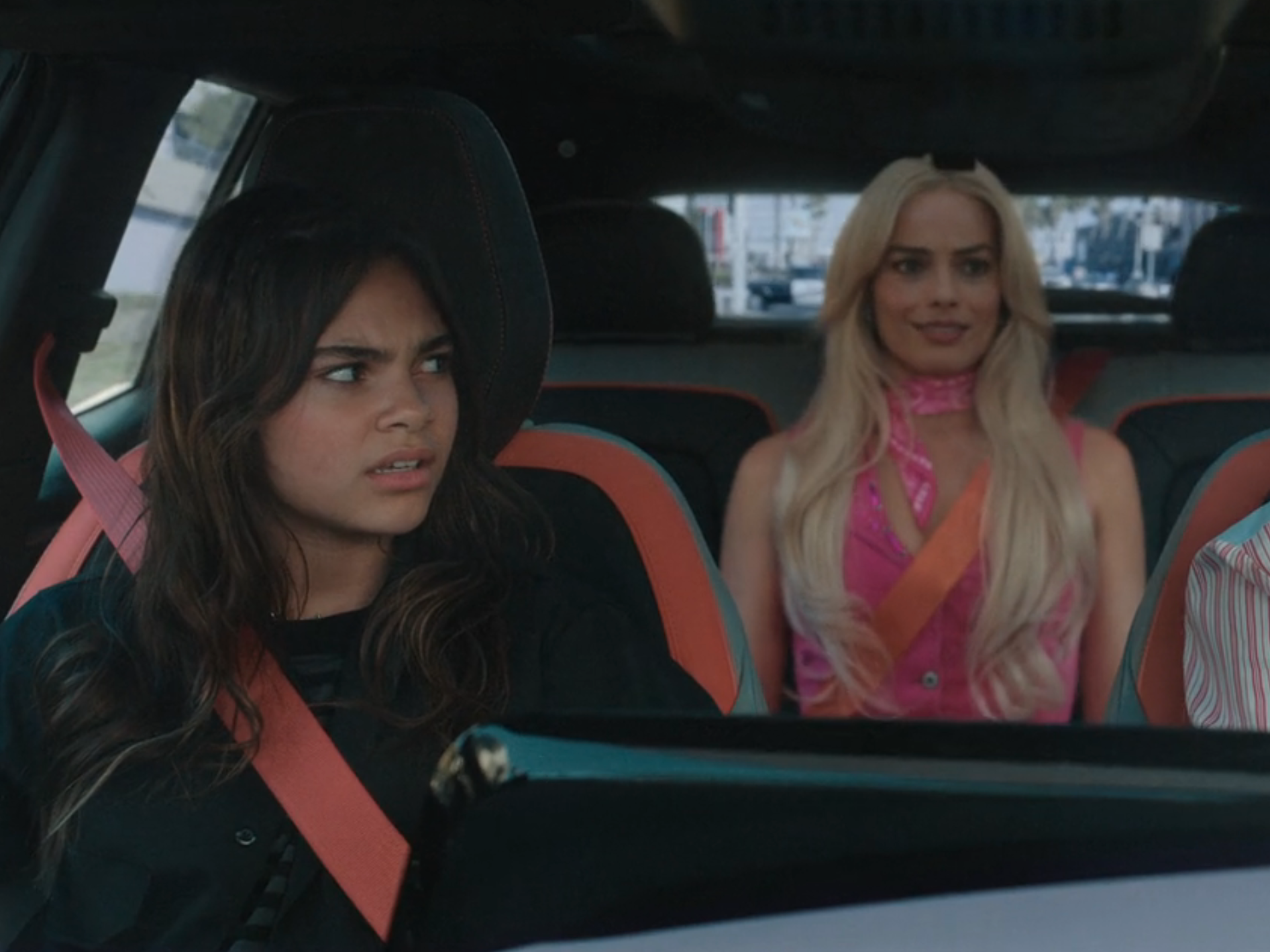
Sasha makes a reference to "The Shining" during the car-chase scene.
When Gloria saves Stereotypical Barbie from Mattel, the pair begin to bond and Barbie realizes she has found her real owner.
In one moment, they both look at each other deeply without saying anything.
Sasha breaks up the moment by saying: "Are you two, like, shining? Are you shining with a real Barbie?"
In "The Shining," another WB movie, shining refers to a telepathic ability that allows people to communicate without speaking.
Warner Bros.
-
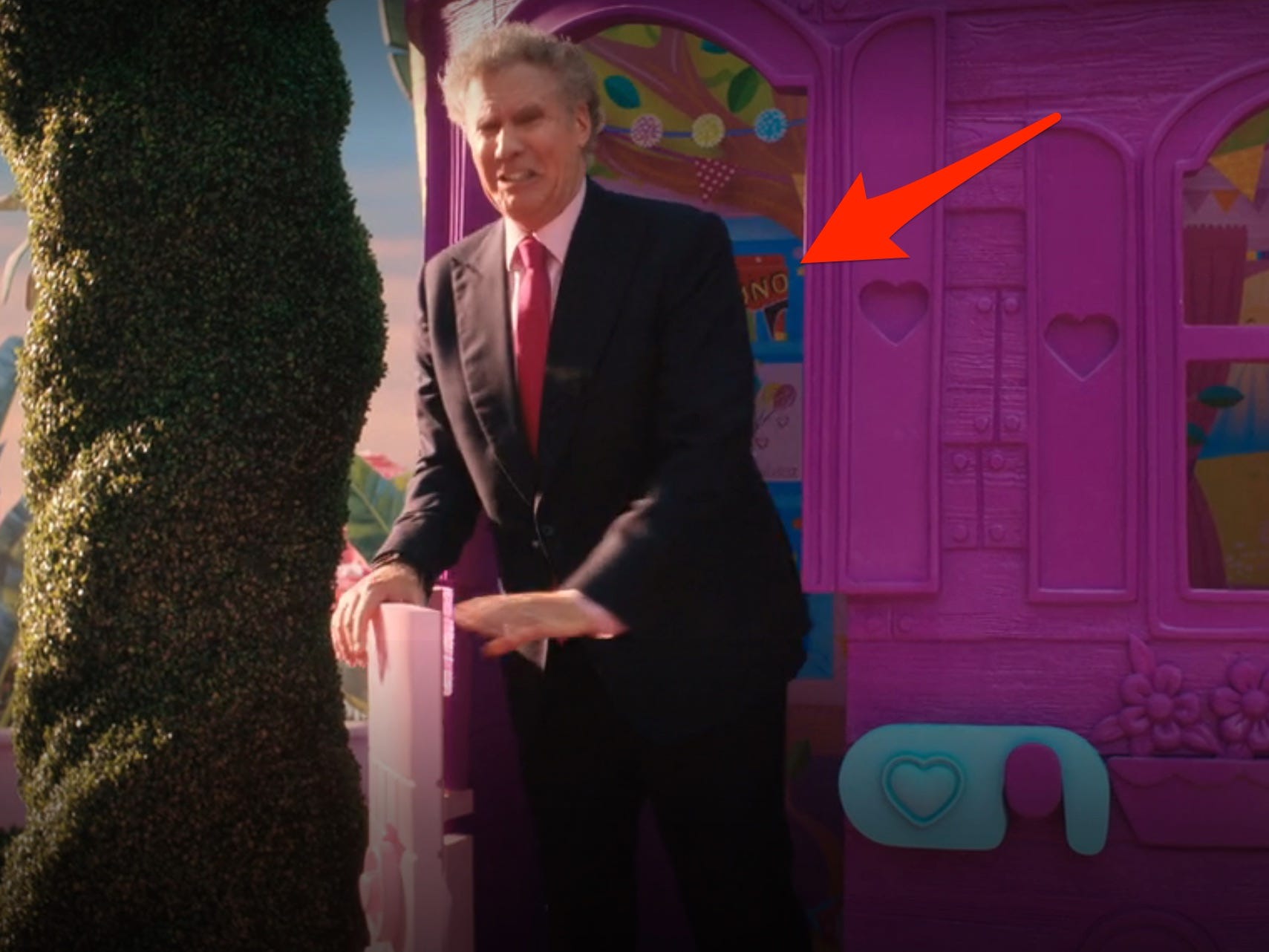
An Uno deck pops up twice in the film, likely hinting at Mattel's upcoming project about the game.
The cards can be seen in a box of old toys during a flashback scene and near the film's end when Ferrell's character walks out of a purple house.
Back in 2021, it was reported that Mattel was developing an action-heist-comedy film inspired by Uno, with the rapper Lil Yachty.
Warner Bros.
-
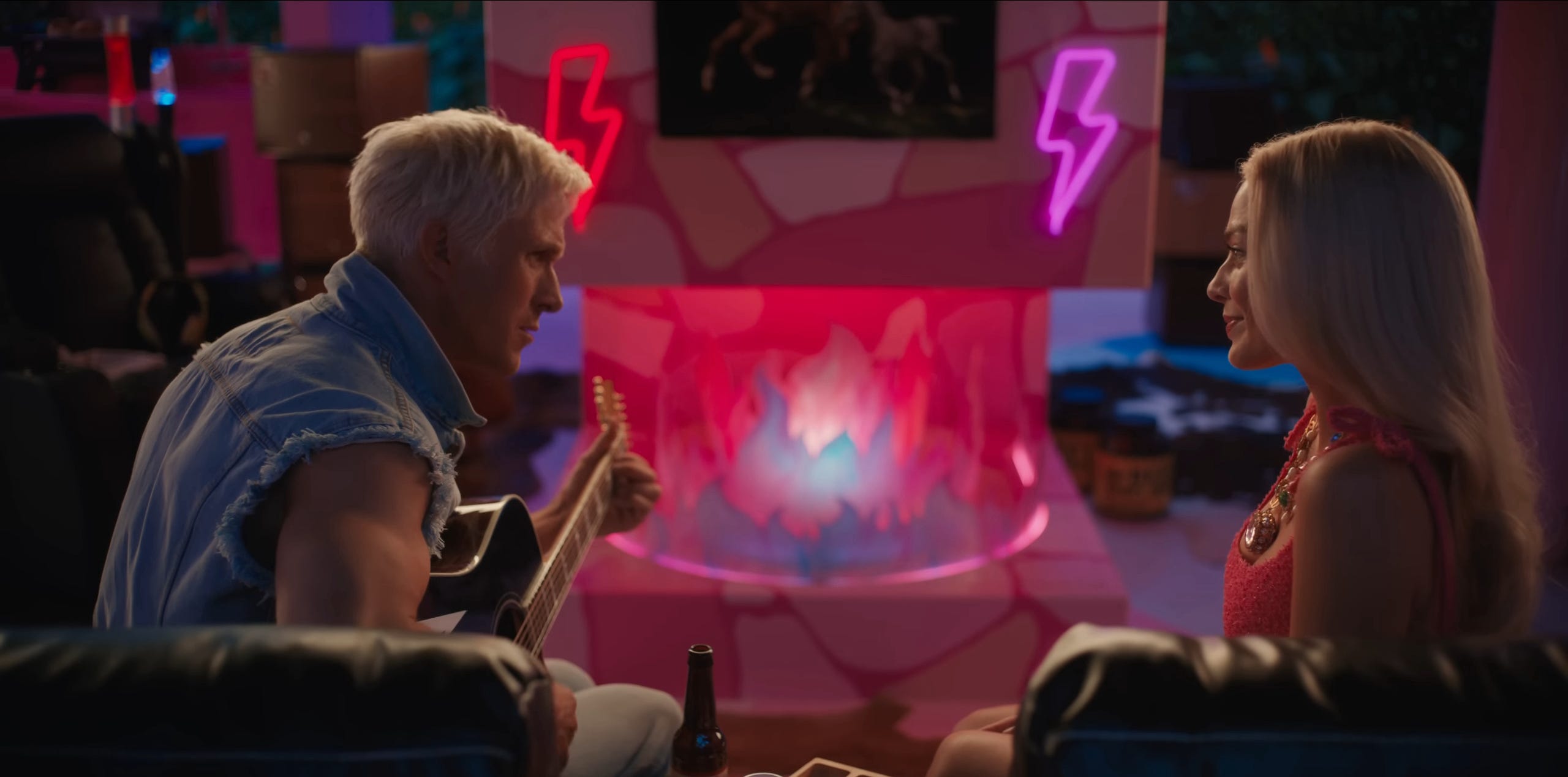
When the Kens take over Barbie Land, the song switches to "Push" by Matchbox Twenty.
This is referred to as Ken's "favorite song."
When "Push" was released in the '90s, the lyrics were misinterpreted and the song was considered anti-feminist. However, lead singer Rob Thomas cleared up the controversy in past interviews, explaining that the song was inspired by a toxic ex-girlfriend and the lyrics are about a person being emotionally pushed.
"It's not about beating women, that's for sure," Thomas told MTV. "In fact, in the song I turned around the point of view on it. It was actually about a relationship that I was in and how I was being manipulated. It was all about emotional manipulation and emotional violence."
In "Barbie," Gosling's Ken has mounting insecurities about not being loved by Stereotypical Barbie, which push him toward the patriarchy and a desire for control of Barbie Land (which becomes renamed as "Kendom").
Gerwig also told Indiewire that she loves the band.
"I will say there were many notes, many notes sessions on all fronts, but the thing is that anything that have in a movie, any reference — and we reference 'The Godfather,' Matchbox Twenty, Dave Matthews Band — I love all of it," she said. "I never put anything in a movie I don't love, and that's true. I don't really have use for things that I don't have affection for, within a movie. That was the core of it."
Warner Bros.
-
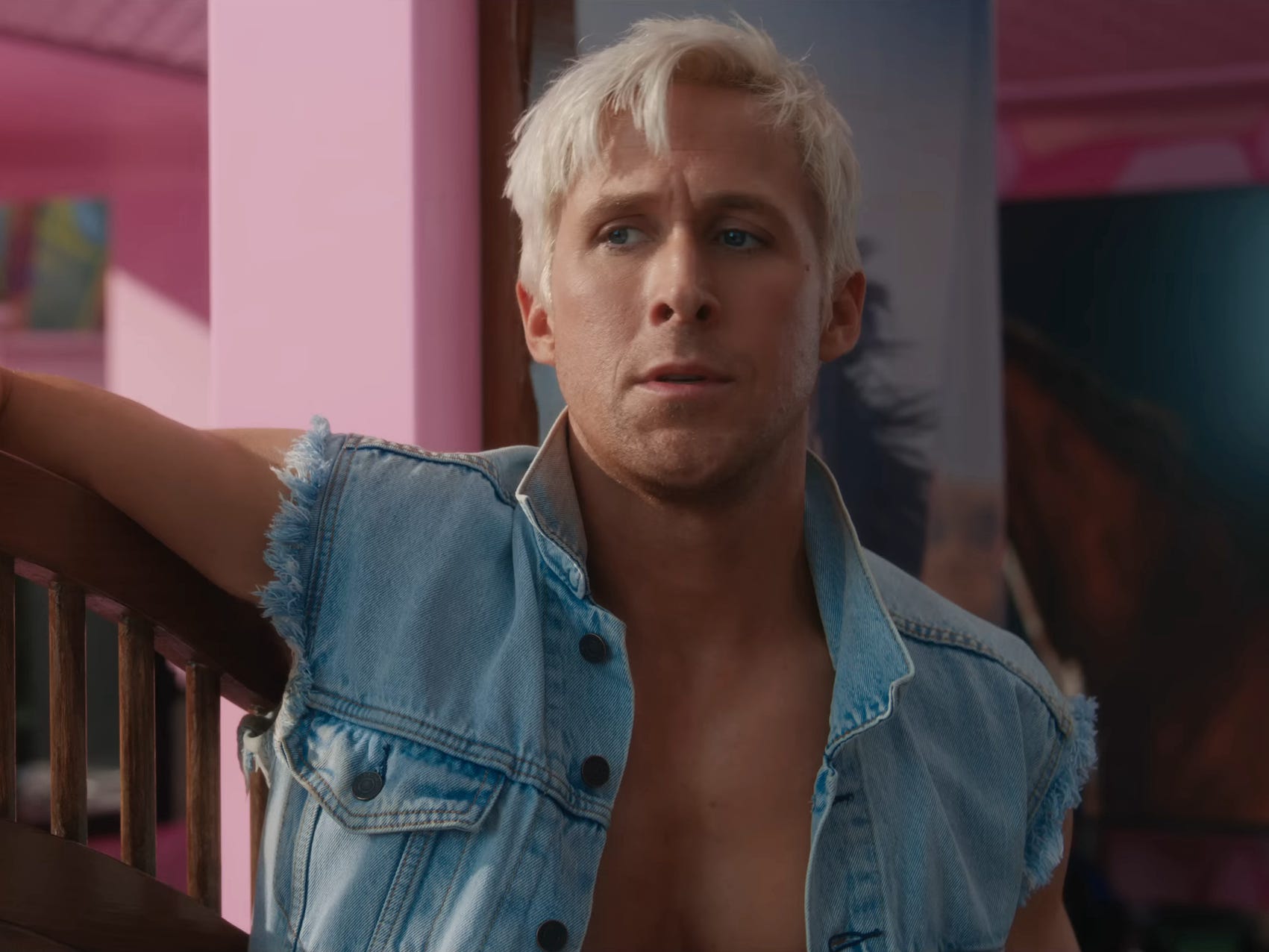
When Barbie visits Ken to tell him she's ready for a relationship, he rushes to the door with a book in hand and says, "Oh hey, you caught me reading."
Gosling told IMDb that Robbie gave him a Ken-themed gift on set "every day." In the film, he holds up a horse book that Robbie gave him as a joke in real life.
Warner Bros.
-
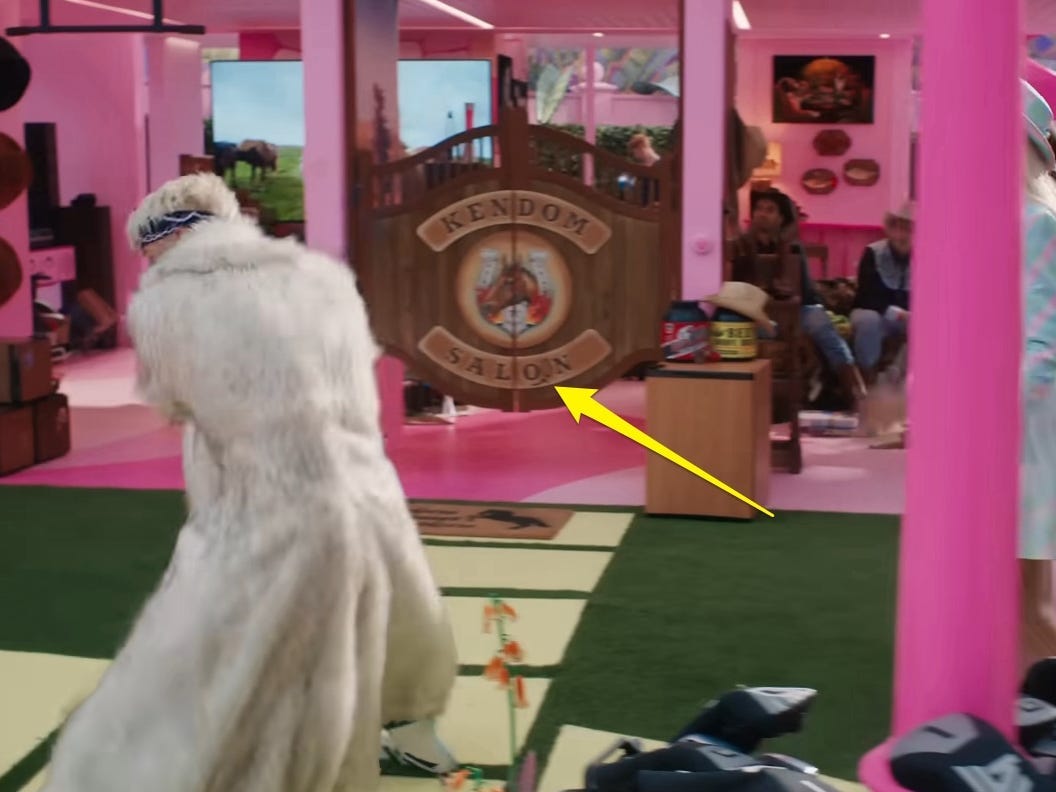
When the Barbies reclaim Barbie Land, the Kendom saloon sign and horse are still in Stereotypical Barbie's house, indicating that Ken still has a place there.
The sign for "saloon" also has an "o" drawn in, because it was accidentally misspelled as "salon" the first time.
Warner Bros.
-
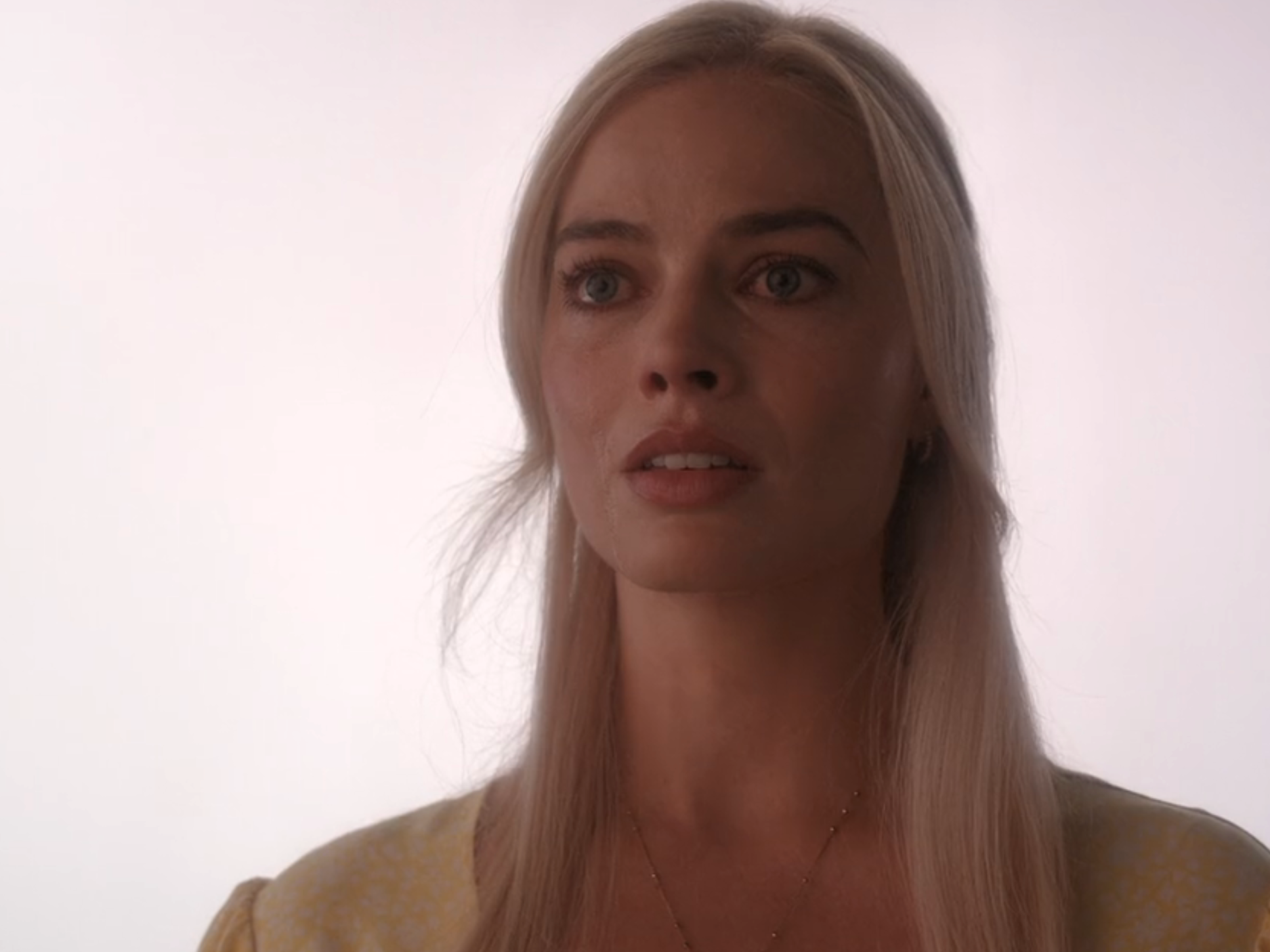
The montage of real women near the film's end features video from the movie's cast and crew.
"I wanted that moment in the film to be truly made by the people who made the movie," Gerwig told celebrity interviewer Andrew Freund.
"I sort of said to everyone — cast, crew, everyone from editorial, anyone — 'If you have things that you're comfortable with sharing, this is an idea,'" Gerwig added.
Gerwig said they received footage of people's friends, aunts, mothers, daughters, and sisters.
Warner Bros.
-
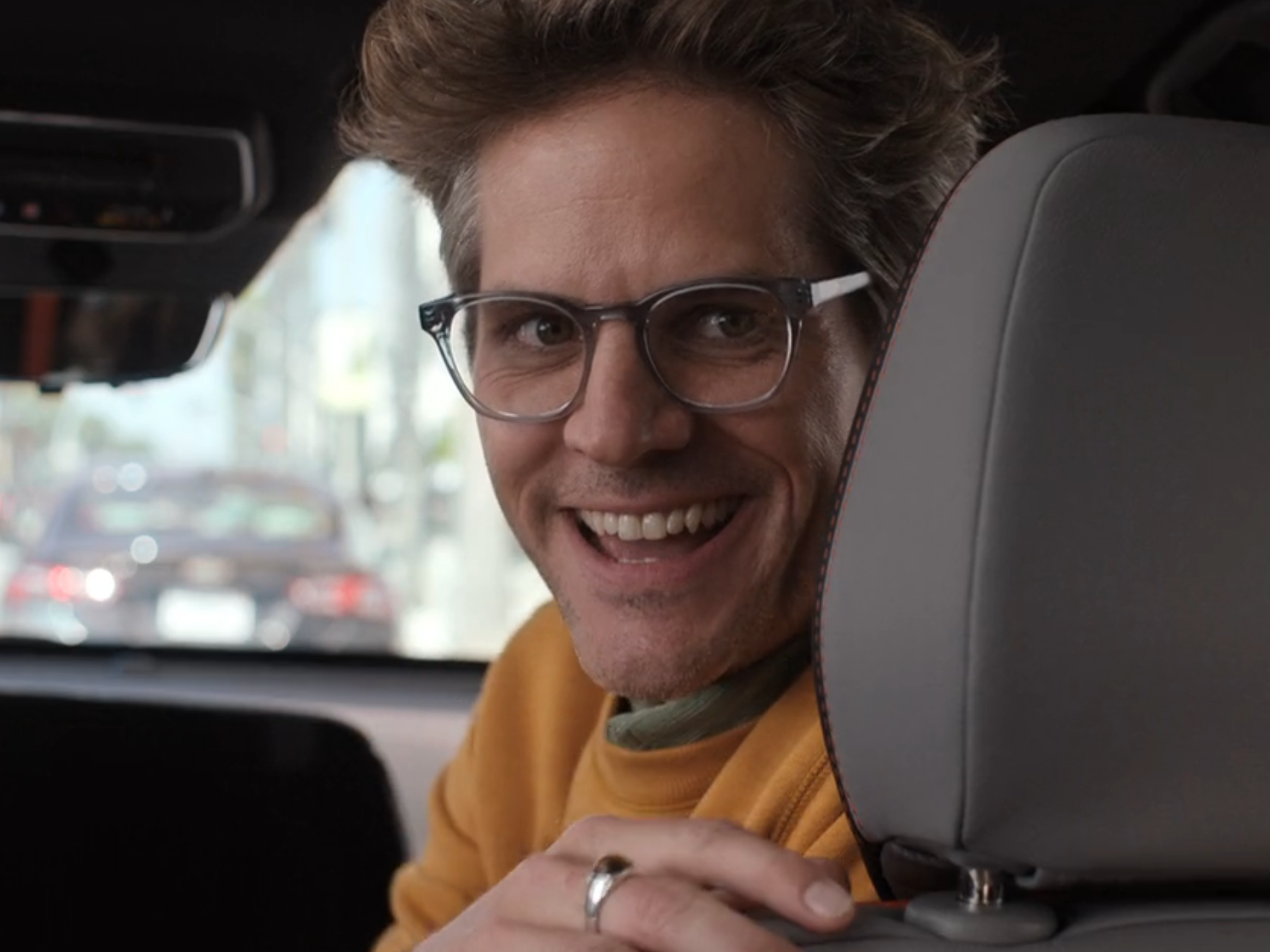
Gloria's husband is played by America Ferrera's real-life spouse, Ryan Piers Williams.
In the movie, Gloria's husband is seen learning Spanish on his smartphone. He also pops up near the end of the film in a car with Gloria and Sasha, as they drop Barbie off at her first-ever visit to the gynecologist.
The character is listed in the credits as El Esposo De Gloria, which is Spanish for Gloria's husband. He's played by Ferrera's real-life husband, Ryan Piers Williams. They've been married since 2011 and have two kids.
Warner Bros.
-
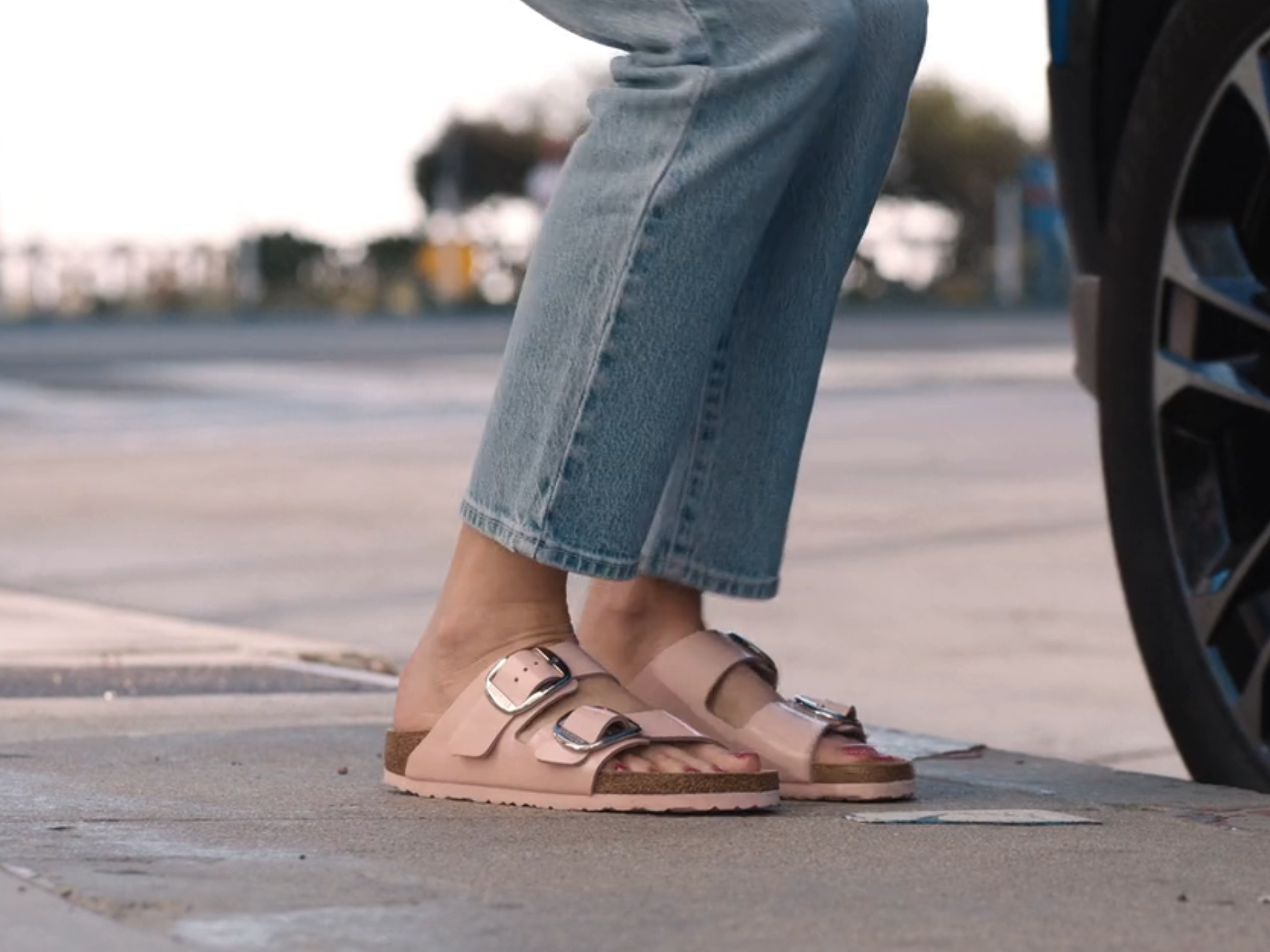
When Stereotypical Barbie moves to the real world at the end of the movie, she's now wearing Birkenstocks — and they're pink.
As she goes to the gynecologist's office, she says that her name is Barbara Handler — a nod to Ruth Handler's daughter who inspired the Barbie dolls.
Warner Bros.
